Hand-written Letterhead (420 results)
Product Type
- All Product Types
- Books (216)
- Magazines & Periodicals
- Comics
- Sheet Music
- Art, Prints & Posters
- Photographs (2)
- Maps (1)
-
Manuscripts &
Paper Collectibles (201)
Condition
Binding
Collectible Attributes
Free Shipping
Seller Location
Seller Rating
-
Typed letter signed ("Henry Moore").
Published by Hoglands, Perry Green, Much Hadham, Herts., 15 May 1948., 1948
Seller: Antiquariat INLIBRIS Gilhofer Nfg. GmbH, Vienna, A, Austria
Manuscript / Paper Collectible Signed
Two pages, closely typed on two octavo sheets of letterhead. Folded for mailing, otherwise very good or better, with the original typed envelope. Enclosed in a folding half morocco clamshell case. A fine letter from the artist, addressed "Dear Miss [Irene] Rosen", in response to her enthusiastic letter written after a viewing of his sculptures at the Art Institute of Chicago (a carbon of her letter is present). In a substantially better than ordinary response by the sculptor to his public, and after apologizing for the delay in his response, Moore writes: "[.] As to your touching the pieces of sculpture at Chicago, you were right and the guards were wrong. If you can get a better idea of the volume of the mass, of the depth of the space and of the hardness of the material by touching a sculpture as well as looking at it, you must do so. I much enjoyed seeing a work of mine which had been in a museum in a mining town in England for many years and which had become dirtied in places where the miners, dropping into the museum on the way home for work, had run their hands over it". In response to her query about the possibility of reproductions of his sculptures, he writes "As to reproductions, I don't think they are worth making unless they're good; it's the same thing with pictures [.] reproductions of sculptures [.] can't be any good unless each cast is worked on by the artist -- and no artist has time to do that to a large edition of reproductions [.]". He details how his editions of bronzes are produced, comments on their availability and price ("which is, I imagine, more than you can afford to pay"), and responds to her complaints about the inadequacy of the reproductions of photographs in J.J. Sweeney's book: "In feeling the limitations of photographs you are certainly on the right lines [.] a reproduction in a book can never have the same beauty or fidelity as an actual photographic print [.]". He concludes in appreciation of her "genuine and intelligent interest" and notes that he his sending her separately a photograph (not present) of his latest carving. Signed in ink, "Henry Moore".
-
Poem "The Gift", :Mary Mother of God written for Miss Elena de Hellebranth,Typed Signed Letter by
Published by RUTHERFORD, NJ, 1955
Seller: Princeton Antiques Bookshop, Atlantic City, NJ, U.S.A.
Condition: Good. letter dated Sept. 23, '55, letter regarding a cancelation for a dinner invitation and says his poem :Mary Mother of God was written for Miss Hellebranth, includes typed and signed poem "The Gift" which was in williams book Desert Music and Other Poems 1954 LIMITED TO 100 SIGNED COPIES , letter typed on personal letterhead "William Carlos Williams 9 Ridge Road Rutherford, N.J.", poem age toned, post marked envelope rutherford, new jersey. WE ALSO HAVE A SIGNED COPY OF THE BOOK DESERT MUSIC. BIOGRAPHY OF THE ARTIST; Bertha de Hellebranth and her sister Elena were born into a cultured upper-class family in Budapest, Bertha in 1899, Elena in 1897. Their father was a lawyer and their mother a student of Franz Liszt's last living pupil. Both sisters showed artistic potential early, beginning to paint at four or five years of age. Their parents encouraged them, and had the means to send them to the best art schools of the time. They studied at the Academy of Fine Art in Budapest, at the Académie Julian and the Académie de la Grande Chaumière in Paris, and painted portraits of European nobility. As Patricia Fazekas points out, "Growing up in a family of privilege, they seemed to have unusual access to many illustrious people." So we should not be surprised to find among their subjects members of high society, such as Count Andrássy Gyula, the Russian-born Princess Baby Galitzine, and Admiral Horthy Miklós, the Regent. Later on, their subjects included American heiress Gladys Vanderbilt (Countess László Széchenyi), President Theodore Roosevelt's granddaughter Paulina Longworth and former President Dwight D. Eisenhower.Often, the sisters would paint the same subject at the same time, offering the sitter a choice of portraits. Most often, the sitter wanted both renditions.While Elena concentrated on working in oil and watercolor, Bertha used gouache and oil to achieve her effects. Elena gave lectures and workshops, was a writer and also wrote popular and ecclesiastical music, while Bertha also went in for sculpture and handicrafts.From the mid-thirties until World War II, Bertha and Elena divided their time between their home in Budapest and a home on the ocean at Ventnor, NJ. In 1925, they showed their work at the Nemzeti Szalon in Budapest, and in 1926, they had a joint exhibition of their portraits in the US. Both exhibited their work at the Art Institute of Chicago, the Brooklyn Museum of Art, the Pennsylvania Academy of Fine Arts and most major museums and galleries in the US. Bertha also had exhibits at the Metropolitan Museum of Art. Both Bertha and Elena were Fellows of the Royal Society of Art (London), and garnered numerous prizes. Bertha was awarded First Prize by the National Academy of the American Water Color Society one year, and the Grand Prize of the Audubon Society. She was one of the founders of the now defunct World League of Hungarian Artists Abroad (Külföldi Magyar Képz?m?vészek Világszövetsége), and received a Gold Medal from the Cleveland Árpád Akadémia in 1963. (Elena also received the Akadémia's gold medal in 1965.) Their work is found in museums and galleries too numerous to mention.The de Hellebranth sisters were devout Catholics, and this is evident in their many portraits of clerics and religious subjects. Bertha's religious sculptures include not only the Patrona Hungariae which was given to St. Emery Church by the Transylvanian Franciscans in 1957, but also several now in the Museum of the American Hungarian Foundation in New Brunswick, NJ, as for example a statue of St. Francis and another of Christ. Elena contributed several folk style panels to the Hungarian Pavilion's display at the 1939 New York World's Fair, while Bertha exhibited a couple of sculptures, one entitled "Sleeping Shepherd".Bertha and Elena became American citizens in the 1940's, but as Elena remarked, "While we are Americans, the Hungarian blood still boils through us." DATE PUBLISHED: 1955 EDITION:
-
1855 Original Handwritten Notebook and Relic of Yale Scholarship by a Prominent 19th Century American Academic
Published by Yale University, Olivet College, 1855
Seller: Katz Fine Manuscripts Inc., Cochrane, AB, Canada
Hardcover. Condition: Good. Dust Jacket Condition: No Dust Jacket. On offer is a terrific collection of early writings from John Haskell Hewitt, a leading early American classical scholar. This 1855 journal is a series of reflections on sermons and lectures that Hewitt attended as a student at Yale University: "The theme was the duties of life in relation to divine providence. The speaker divided the subject into 3 general heads. 1st What is understood by Providence. Secondly Duty of Consenting to that Providence. Thirdly Duty of Submitting to that Providence" (pp. 18-19). "There are in every science certain rudiments of first principles on which all others depend and from which others proceed. In every concern it is well to keep in view the rudiments. In the Legislature, the Constitution, is looked to, in Navigation, the compass. The same is true in Religion. There are certain fundamental principles in this, which must be regards" (pp. 28-29). His loose-leaf notes date at least until the late 1870s. Some are on the letterhead of Olivet College, showing him as Acting President, which date then to 1877 at the earliest, when he was so appointed. They cover a wide range of subjects. Many appear to be notes for talks or lectures. "A History as has been shown is philosophy teaching by example . First Colonial Congress in NY, Oct 7, 1765, 9 Colonies, 28 delegates, Agreed on Declaration of Rights." One group of notes has a page dedicated to each of several American states, many referring to the early history of the relevant state, especially vis-a-vis independence. Hewitt was born in 1835. He entered Yale University in 1855, the year this journal was kept. After his graduation, Hewitt stayed at Yale, serving as a librarian there. In 1865 he accepted a teaching position in Olivet College in Michigan. In 1882, the president of Williams College in Massachusetts (and a friend of Hewitt s from Yale) , Franklin Carter, offered Hewitt a prestigious professorship in ancient languages. Hewitt accepted, serving Williams College in various capacities for the rest of his life. He became Professor Emeritus in 1909. He passed away in 1920 at the age of 85. This small notebook measures 6.25 inches by 7.5 inches and contains 50 pages. It is about 90 percent complete. The cover is in good condition, as are the binding and pages. The handwriting is legible. Accompanying this notebook is a collection of some 108 pages of loose-leaf notes. For an historian, this is an outstanding look into the thinking and writing of a man recognized as a leading scholar in 19th century America. For alumni of these great institutions, this would be an excellent addition to or anchor for a collection of memorabilia. ; Manuscripts; 6.25" x 7.5"; 50 pages; John haskell hewitt; yale university; yale; history of yale; olivet college; williams college; american scholar; americana; handwritten; manuscript; document; letter; autograph; writer; hand written; documents; signed; letters; manuscripts; diary; diaries; journals; personal history; social history; historical; holograph; writers; autographs; personal; memoir; memorial; antiquité, contrat; vélin; document; manuscrit; papier antike; brief; pergament; dokument; manuskript; papier oggetto d'antiquariato; atto; velina; documento; manoscritto; carta antigüedad; hecho; vitela; documento; manuscrito; papel.
-
1861-1863 Archive of Five Civil War-Era Manuscript Letters Relating to the Robust US Banking System, Army Units, Debts, Corporate Elections
Published by Civil War America, Bank of America, 115th Ohio Infantry 1861-1863, 1861
Seller: Katz Fine Manuscripts Inc., Cochrane, AB, Canada
Manuscript / Paper Collectible
No Binding. Condition: Very Good. On offer is a unique collection of five letters that detail several financial transactions during the American Civil War. The first letter details a financial transaction between one J. C. Anderson and a Mr. D. McLaren. McLaren is identified further on in the note as "Brigadier of the 115th Ohio Volunteers". The 115th Ohio Infantry was organized Massillon, Ohio, and mustered in September 18, 1862, for three years service under the command of Colonel Jackson A. Lucy. After being raised, they were moved to Cincinnati, Ohio. They were assigned to duty by detachments as provost guard and guarding forts, arsenals, store houses, and magazines at Camp Chase, Camp Dennison, Maysville, Covington and Newport, Kentucky, and Cincinnati, Ohio, until October 1863. They were then ordered to Chattanooga, TN, then to Murfreesboro, TN. They were stationed at Murfreesboro and along line of the Nashville & Chattanooga Railroad, in block houses and at bridges until June 1865. The Regiment was specially selected for this arduous duty because of the great number of skilled mechanics and artisans in its ranks. They were involved in actions at Cripple Creek, Woodbury Pike, the siege of Murfreesboro, "The Cedars" and Lavergne. The Regiment was mustered out of service June 23, 1865, at Murfreesboro, TN. The letter, drafted in Carlisle PA on May 6, 1861 is addressed to a D. McLaren. In the salutation, he is referred to as Superintendent but further down the letter, he is addressed as Brigadier D. McLaren of the 115th Ohio Volunteers. Our research has not turned up anyone of that name who served in that rank in the 115th Ohio Volunteers. The letter requests the transfer of $300.00. The second letter is addressed to a Mr. F. H. Short and was drafted June 5th, 1862. It was written by a Mr. S. R. Drury. The letter concerns an apparent debt that is owed to Drury and steps he wishes to take to collect on it. It includes this interesting line: "As I never allow an Irishman to get ahead of me in pmts, I wish you to instruct whoever pays him to ." . The third letter is also addressed to the same F. H. Short. It is dated in New York on April 28th, 1863. The writer is one E. R Bell. The letter concerns the attempt to collect proxies for a corporate election. In the letter, reference is made to a 'President L'Hommedua'The fourth letter, again addressed to F. H Short, on letterhead of the Bank of America. It was written by Robert Jaffray, Transfer Clerk at the Bank. The letter is dated Nov 20, 1863. In it, Jaffray advises Short that his account has been charged $20 for Government Stamps. He also states that the Certificate Book is nearly depleted. This refers to the share certificates that a company would issue to new shareholders. It appears that Short is using the Bank of America as his company's Transfer Agent. Our research has identified Robert Jaffray. Jaffray was born in Manhattan in 1824. He worked for the Bank of America in New York City. He passed away in 1902 at the age of 77. The fifth letter was written by S. R. Drury on Oct 31st, 1863. Directed to the addressee, whose name cannot be read, it advises of a meeting date and time and requests some details of attendees. For a historian, these letters hint at the range of banking business that was being carried out in the mid 19th century America. From covering payments to army units fighting in the Civil War to general corporate business, one can see the robust American banking system in play. The Bank of America can trace its roots back to 1784 and today is the second largest banking conglomerate in the United States. This is a fine collection of primary-source banking instruments from a turbulent and fascinating time in America's history. The letters are in excellent condition. The handwriting is in a copperplate font which offers challenges to the modern reader. However, the script is clearly written. ; Letters; 8vo 8" - 9" tall; 5 pages; Keywords: handwritten, manuscript, document, letter, autograph, writ.
-
Stiff Wraps. Condition: Very Good+. First Edition. Original gilt-pictorial red wraps, minor edge wear, 50 pages. Laid in is the author?s three page hand-written manuscript of lyrics for ?Pecos Tom,? on Thorp?s Livestock Company Letterhead, signed at the end by Thorp with his Diamond T brand. It appears that ?Pecos Tom,? was published a few years later in 1921 in the author?s anthology of cowboy songs. Merrill Aristocrats, "First book of cowboy songs." Dykes, Kid 56.
-
No Binding. Condition: Fine. Autograph letter, signed "W. T. Sherman," to Mary Audenreid (St. Louis 1883); single leaf, octavo, folded to form four pages; on personal letterhead; unpublished. "I was specially pleased to learn from your good letter of the 19th just received that you were first recovering from the dreadful shock of my official service and beginning to mingle with this gay world I somehow I don't estimate your friend Robertson as high as some do. His vanity seems excessive, and he is somewhat indiscriminate in his attentions. A lady may receive the adulations of any gentleman and claim the rightful privileges of her sex the moment his attentions pass the limit of what she construes propriety. So every man loves the endearments of a woman, especially a pretty one, only he too is limited by the dread Rules 'Propriety.' As each sex construes this Rule for itself there is plenty of room for scandal. I think [Preston] Plumb [Kansas Republican senator] is an honorable man, but somehow I don't like to associate his name with yours that he admires you as much as you will let him is natural and proper but for life think a good many times. You are in no hurry, for unless some transcendent man and genius comes to you first, I somehow want you to wait now till Florence [Audenreid's daughter] is well married. That cannot be long, for this girl will be most attraction and fascinating to men - her willfulness and waywardness will be construed as smartness and vitality and as soon as she is out she will be the center of attraction. I have not heard from her, or of her except what you have written since I left New York, but yesterday I did write to her at Mrs. Reed, asking her to continue to write me, as I think it will do her good to empty her mind to some old fellow like me who can have but one motive, and that her ultimate good. Lizzie [Sherman's daughter] and I intended to drive out to Mrs. [?] in the country - today, but it proves to be one of those rainy, murky days when indoors is a necessity. I have a series of dinners and parties on hand to the end of November. So as yet I have no occasion to feel the ennui of this idle life. [John E.] Tourtelotte [Sherman's former aide] is now at work on my scrap book in my back office [in] the Old Dining Room. Rachael [Sherman's daughter] was at home last night and our parlors were well filled & c. Affectionately, your guardian." ----- According to biographer John Marszalek, Sherman became involved with Mary Audenreid, the wife of his aide, Joseph Audenreid, in the early 1880s. The two men had known each other for a long time, Audenreid first beginning service with Sherman in 1863. Mary had no special relationship with her husband's boss, but this changed in mid-June 1880 when Audenreid died after an extended illness. Soon Sherman was filling his letters to her with advice about how to get over her depression so she could continue raising Florence, her daughter. Eventually, she began to view the general romantically and reacted with mixed feelings. Mary was not discouraged; she continued her suit. In the end, Sherman settled for flirtations, public kisses, and, perhaps, brief liaisons. The relationship lasted until his death in 1891. A suggestive piece with biographical relevance. Signed by Author(s).
-
[REPUBLICAN TURKISH UROLOGY and RESEARCHES on HERMAPHRODITES] [Collection of autograph letters, photographs, case registers and other documents].
Published by [Cafer Yildiran], [ca. between 1940-1980], 1970
Book Signed
No Binding. Condition: Very Good. A large collection including 150 autograph letters signed 'Cafer Yildiran', his other family members and medics. Most of them are in Turkish, several ones are in English, French, and German. Letters written by him and to him mostly with his wife. Written from Istanbul, USA, Europe (Germany), Trabzon and Edirne cities. He tells about his profession and other things in his letters. In addition it includes one telegraph, one hand-drawn painting on paper, several letters from his children, and one poem which was written by him to his son. Also collection has many photographs and x-ray pieces. They're separated as files and each file has photographs and notes. First file includes 10 photographs in 9 plates. Second one has around 30 photos, third one has many photos of his patients and x-ray photos in 10 plates. All photographs are original. In addition there are 50 photos out of files. One big file has detailed case registers during his working in Cerrahpasa Hospital between the years of 1956-1959 and in Haseki Hospital between 1959-1966. File is titled as 'fihristler' [i.e. indexes]. They include cases, patients' personal information (like their names, ages and which cities they came from). It has around 500 pages. In addition to all of these, another documents which have three b/w plates from a urology book printed in Ottoman script (Turkish with Arabic letters), two business cards of Yildiran, four blank envelopes with his personal and 'Turkish Urology Society' letterhead, a certificate of participation of 17th Urology Congress in Turkey (Antalya city) with autograph signature of Vural Solok (President of Turkish Urology Society in its period), prescriptions, some correspondences of Diyarbakir and Polatli Rotary Clubs, Admiral Bristol Hospital and other corporates (around 15 documents), and other several documents. Cafer Yildiran was born in Mersin in 1916. In 1941, he graduated from Istanbul University Faculty of Medicine. He specialized in urology. He worked at Vakif Gureba Hospital, Trabzon Numune Hospital, Cerrahpasa Faculty of Medicine. He was sent abroad by the Turkish government. He conducted various scientific studies in England and USA. In 1959, he was appointed as the chief of urology at Haseki Hospital. He retired from the same hospital in 1981. He has over 300 publications, two scientific books, one poetry book and two congress reports. He is a founding member of Turkish Physicians Solidarity Foundation. A fine and large collection on Republican urology including some unique photographs on Turkish hermaphrodite researches. Signed by Author(s).
-
The Seafighters (The Sea Fighters) [Operation Bikini] [Original Working Screenplay / Script for the 1963 Movie - Operation Bikini]
Published by Alta Vista Productions / American International Pictures [AIP], Los Angeles, 1962
Seller: Bookwood, Melbourne, VIC, Australia
Book
Hardcover. Condition: Very Good. RARE ORIGINAL SCRIPT for "THE SEAFIGHTERS" (working title, 1962), the title of which was changed to "OPERATION BIKINI" (1963). This is the SECOND REVISED FINAL DRAFT - November 19, 1962. Screenplay by John Tomerlin. The film starred Tab Hunter, Frankie Avalon, Jim Backus, Scott Brady, Gary Crosby, & Eva Six. This original Hollywood script belonged to well-known cinematographer Gilbert Warrenton, with his handwritten name taped to front cover, & who is listed on staff sheet as cameraman. Includes laid-in folded blank sheet with Warrenton's printed letterhead ("Gil Warrenton, Prod.") & his address on Sunset Boulevard in Hollywood (has heavy edgewear with chips & tears). Gilbert Warrenton (1894-1980) was a prominent American silent & sound film cinematographer. He filmed over 150 films before his death. Notable credits include The Cat & the Canary (1927) & several B-movies of the 1950s & '60s. He was the son of actress Lule Warrenton. Alta Vista Productions - Prod. #1071. Operation Bikini (1963) was directed by Anthony Carras (notable editor, producer) (1920-2007), who worked on many classic 1950s/'60s movies, including Poe's House of Usher, Pit & the Pendulum, & Tales of Terror. Operation Bikini was written by John Tomerlin, who wrote various TV shows in the 1950s/'60s, including S.W.A.T., The Twilight Zone, & The Picture of Dorian Gray. The tagline of Operation Bikini was "Temptation in Paradise - Neither Hell or High Heels Could Stop Them". Full contents of this original working script as follows: cast list; staff sheet; 4 sheets of handwritten notes; front cover card; title page; pages 1-107 inclusive (with some page inserts) (all printed on rectos only); 16-page production/shooting schedule (indicating 10 days of shooting); cast list; rear cover card; an additional 3 sheets of handwritten notes; business card; time card; call sheet. Tabs on many pages. Contains numerous handwritten ink & pencil NOTATIONS throughout. From IMDb: "With posters featuring a stylized-drawing of Eva Six in a bikini, a tagline reading 'Temptation in Paradise - neither hell nor high heels could stop them', & a Dream Sequence Technical Adviser credit for Bob Marcucci, American-International once again proved it had no peers when it came to sleight-of-hand advertising selling a war-movie when war movies weren't selling. This one starts in the Pacific in 1943 when an American submarine staffed by the likes of Scott Brady, Jim Backus & Michael Dante (the old guns to get the old folks in) has a rendezvous with a cruiser to pick up an underwater demolition team comprised of the likes of Tab Hunter, Frankie Avalon, Gary Crosby & Jody McCrea (the young turks to get the kids in, which probably only worked in Southern California), & there is conflict right off as the sub crew feels like they are being denied a chance to revenge the sinking of a sister sub because they have to deliver Tab & Frankie to an island on a super-secret special mission guaranteed to affect the entire course of the war in the Pacific. These guys are landed on the Japanese-infested island & find their guerilla support consists of an old man, a teen-ager & three girls." The 77-minute b&w movie was released 26 March 1963. It rates 3.8/10 on IMDb. Frankie Avalon sings in two musical interludes - which were shot in color, despite the rest of the movie being shot in b&w. American International Pictures (AIP), a film production company formed in 1954, were dedicated to releasing independently produced, low-budget films packaged as double features, primarily of interest to the teens of the 1950s, '60s, & '70s. Bound in black buckram boards, title & Warrenton's name handwritten on tape affixed to front board. Covers & spine heavily worn, internal wear, otherwise a nice tight solid copy of an original working script. Large format heavy volume, extra shipping may be required. A scarce & unique piece of classic 1960s Beach Party Hollywood. RARE.
-
The Old Peabody Pew
Published by Houghton, Mifflin and Company, Boston, 1907
Seller: Courtside Books, Medford, NJ, U.S.A.
Book First Edition Signed
Hardcover. Condition: Near Fine. No Jacket. Alice Barber Stephens (illustrator). 1st Edition. Illustrations by Alice Barber Stephens. Inscribed by Wiggins to her publisher Roger Scaife on the title page: "Kate Douglas Wiggin to Roger L. Scaife 1907." Wiggin has written an additional inscripton to Scaife on a front fly leaf with a quote from the book: "To my good friend and appreciative reader Roger Scaife, who heard this story read in the old church at Buxton. Kate Douglas Wiggin. 'You can't do a thing with men folks without they're right alongside where you can keep your hand and eye on 'em! Page 142.'" Also, attached to front leaf is a two page letter on Hotel Fontaine, Boston letterhead to Roger Scaife from Kate Douglas Wiggin. " June 18, 1915 Dear Mr. Scaife. The chance meeting with so many representatives of the firm this morning has called up many memories. I was not only the oldest person present, but I believe the oldest member of the Houghton Mifflin Co family, in which I have belonged for more than 35 years. I have never, in all that time, written a book to order or for money alone, nor one which I did not love while I was writing it. The public has stood by me loyally, the publishers have grown from business managers into dear & trusted friends. I do not suppose I undervalue the services of you who have talked about my books throughout the country! I appreciate this with all my heart. I know that a good share of my modest prosperity is due to your ever-ready support of and belief in my work. Gracefully yours, Kate Douglas Wiggin." Slight fading to spine else a lovely near fine copy with a wonderful associaton. Signed by Author(s).
-
Autograph Letter, Signed "L.H.", New York, NY, April 16, 1959
Publication Date: 1959
Seller: The Lawbook Exchange, Ltd., ABAA ILAB, Clark, NJ, U.S.A.
Signed
Letterhead, New York, NY, April 16, 1959]. (illustrator). Letterhead, New York, NY, April 16, 1959]. "Of Course it is Pleasant to Have Folks Gather and Tell You That You are a Hot Potato." [Manuscript]. Hand, Learned [1872-1961]. [Ely, Gertrude Sumner (1876-1970)]. [Autograph Letter, Signed "L.H.", On Hand's U.S. Court House Letterhead, New York, NY, April 16, 1959]. 6-3/4" x 5-3/4" bifolium, text to recto of first leaf and verso of second leaf. Light toning, single horizontal and vertical fold lines. Letter housed in handsome 12-1/2" x 9-1/2" quarter morocco clamshell case with gilt-edged raised bands and lettering pieces. $1,500. * One of the most significant American jurists of the twentieth century, Hand was a judge of the U.S. Southern District of New York, later a judge of the Court of Appeals, Second Circuit. He was renowned for his judgments, which were also admired for their lucidity and elegance. This letter is addressed to a "Gertrude," most likely Gertrude Sumner Ely [1876-1970], who was a longtime friend of the family and particularly of Hand's wife Frances. She corresponded with Hand frequently and had apparently written to congratulate him on the fiftieth anniversary of his appointment to the federal bench. A celebration of that anniversary was held on April 10, 1959. The letter typifies Hand's occasional insecurity and reluctance to accept praise. He remarks: "Of course it is pleasant to have folks gather and tell you that you are a hot potato; but, even when they do it as well as those gents did, who gathered here last Friday, there is a kind of unreality about it, that is disconcerting.I felt as if it was all about someone I didn't know." Hand continued to hear special cases on senior status until his death in 1961. He had previously published two books while in semi-retirement: The Spirit of Liberty (1952) and The Bill of Rights (1958).
-
Collection of Autograph Letters, signed, to Hope Smith
Published by [V.p., Pasadena, Madison, etc., 1931
Seller: James Cummins Bookseller, ABAA, New York, NY, U.S.A.
Eighteen letters. Pen and ink on letterhead, eleven with original envelopes. Occasional red ink highlights and pen doodles. Frederick Jackson Turner (1861-1932) was a native of Wisconsin, and professor at the University of Wisconsin and Harvard, later lived in Pasadena, California. Turner died in 1932 in San Marino, California, where he had been affiliated with the Huntington Library. Turner is best remembered for his substantial essay, "The Significance of the Frontier in American History," published in the Proceedings of the Forty-First Annual Meeting of the State Historical Society of Wisconsin in 1894. Comprising ten letters in original envelopes addressed to "Miss Hope Smith," six hand-written letters lacking envelopes, and one typed letter lacking its envelope; with anenvelope containing newspaper clippings. The letters are on a variety of types of letterhead, and bear postmarks from Pasadena, Boston, and Madison, Wisconsin. This collection of letters, largely social in nature, range from expressions of Turner's delight in receiving news from Miss Smith, comments on her progress in painting and congratulations on successful shows, his wife's comments on also reading Miss Smith's letters, and a sometimes wistful reminiscence of time spent in the summer and fall (but not winter!) in Maine. A later letter requests that Miss Smith come visit, as he does not think himself likely to leave California for the East Coast again. Very Good. Old folds, newsprint clippings in one envelope toned with age Eighteen letters. Pen and ink on letterhead, eleven with original envelopes. Occasional red ink highlights and pen doodles.
-
Gorgeous, Wonderfully Detailed Original Handwritten 1917 Travel Diary by the Wife of a Former Rhode Island Supreme Court Chief Justice
Publication Date: 1917
Seller: Katz Fine Manuscripts Inc., Cochrane, AB, Canada
Hardcover. Condition: Very Good. No Jacket. On offer is a fine journal by Rosabelle Matteson chronicling a cross-continent automobile trip she took in the early 20th century. Rosabelle Matteson was married to Charles Matteson, who had been Associate Justice of the Rhode Island State Supreme Court from 1875 to 1891, and Chief Justice of the Rhode Island Supreme Court from 1891 to 1900. Following Charles Matteson's retirement, the couple commenced a series of travels that took them across the United States and to Europe. Belle Matteson passed away in 1920, and her husband five years later in 1925. This diary chronicles a 1917 road trip across the United States and back. Belle and Charles were accompanied by two female friends. The entries are succinct and well-written, each entry taking up only a page. The author notes places they stayed, distances covered, and incidentals such as hotel costs. This is followed by a rich description of the day's events. "New York / Hotel Theresa 124-128 St. And 7th Av. / Room two beds 4.00 both / 189 miles" (May 10, 1917). While in New York City on May 10, Rosabelle notes the presence of General Joseph Joffre, Commander in Chief of the Army of France, who visited New York that month: "Streets most elaborately dressed with bunting in honor of the French Commissioners. Joffre at head" (May 11, 1917). "Kansas City Bridge and Movies / Very pleasant this morning but more cyclone reports, also floods in the direction we are going. Jennie and Eva went to the Automobile Club of Kansas City and were earnestly advised to wait still a little longer . . . Charles took me out to the soda fountain and back but ate nothing himself. Later, Jennie and I had our hair done and still later Charles read a little from 'The Life of the Bee' which we commenced some days ago. Then dinner at the Savoy and some more movies. Excellent" (June 6, 1917). Their travels took them to the Grand Canyon and on to California. From there, they journeyed north, crossing into Canada to visit Victoria, British Columbia. "This place makes a great impression, the Parliament Houses being very pretentious and the Empress Hotel being large and grand, too much so to compare with the otherwise unpretentious city. The population has been reduced from 60,000 to 20,000 through war conditions. Distressing" (August 24, 1917). The last entry is recorded on October 4, in Cleveland, Ohio. The journal is comprised of 158 single-sided pages, kept inside a silk-lined leather book jacket. The leather cover has hand-tooling designs and features a portrait of a woman. The leather cover shows signs of wear but is completely intact. The pages are in excellent condition and the handwriting is very neat. Interestingly, some pages have letterhead belonging to the Supreme Court of Rhode Island. This is a superb travel journal. It covers an extensive amount of the United States at a time when such travel was uncommon. Automobiles and roads were still in their early stages of development. For a geographer, this is an outstanding travelogue that highlights the many regions of the country. For a social historian, Rosabelle Matteson's observations paint a quick sketch of life across the United States, from the vast prairies to San Francisco's Chinatown. "I am much interested in these ranch ladies whom I meet," Belle writes, "their lives have been so very different from my own" (August 2, 1917). The diary paints a vivid portrait of a long-vanished America.
-
Walk Along the Shore
Published by Circle Press, Guildford Surrey, England, 1977
Seller: Books & Bidders Antiquarian Booksellers, Cleveland, OH, U.S.A.
First Edition Signed
Cloth. Condition: Fine. John Christie (illustrator). Limited First Edition. 10 eight page (unnumbered) sections 33 x 23 cms., loose in black chemise housed in slip case. Illustrated with nine color, tissue protected, screen-prints by John Christie, each signed by the artist. Limited number 17 of 95 copies (80 for sale), SIGNED by both White and Christie on limitation page. Letterpress printed on Velin Arches rag-made paper; typography and presswork by Ronald King, hand-set in 14 point Baskerville by Walter Taylor and Willow King at Circle Press. Four prospectuses laid-in, along with hand-written note SIGNED by Ronald King on Circle Press Letterhead. Sign of bookplate removal, else fine. Size: Folio. Signed. Private Press.
-
Hardcover. Condition: Very Good. Limited Edition. 8 black and white lithoghraphs (including title-page and the circular lithograph on the unnumbered colophon page), 145, (3)p. Original grey (in appearance, but actually woven black and white) cloth. 34 cm. Inked on front pastedown Modest cover wear, including a few brown spots. Former owner's name (Allison . ??) in upper right corner of front free endpaper, possibly written in what may be Elmer Adler's hand. Contents may be slightly age-toned but otherise fine. No jacket. INSCRIBED on front pastedown ("This copy specially inscribed for Steve Patterson by the printer Elmer Adler Princeton, 1 February 1945"). This edition of Beowulf was printed for Random House at Pynson Press, the private press founded by Adler in 1922. Copy #637 of 950 numbered copies which are signed by Rockwell Kent's thumbprint on the colophone page. Laid in is a Typed and Signed Letter (on Kent's letterhead stationery) to Adler from Kent which is dated August 10, 1944 and signed by Kent (as "Rockwell"). Kent apologizes in the letter for not having filfilled (and still being unable to fulfill) an otherwise undescribed "little request" from Adler) which Kent is keeping on his desk and "will as soon as he can." The letter is wrinkled and creased in the (blank) lower right corner. Also laid in is a folded legal size mimeo broadside announcment (letterheaded News from Random House) announcing Kent's Beowulf with a February 20, 1932 Publication Date. Patterson, the inscribee, came from a well-to-do family and was a graduate student in linguistics at Princeton where he was also the student head or just heavily involved in the Princeton Print Club. He later worked for a while in intelligence but was mostly an unpublished poet.
-
Henry Irving. Ellen Terry. etc. A Book of Portraits [With Typed Letter Signed from the Publisher to Ellen Terry and an ALS from Edward to his Sister, Edith]
Published by Herbert S. Stone, Chicago, 1899
First Edition Signed
First edition. A superb association copy of this early illustrated work from English theater designer, Edward Gordon Craig (1872-1966). Contains two pieces of correspondence from the Craig family, the book likely being owned by Edward's (EGC from here on) sister, Edith Craig (1869-1947). The first letter is from the publisher, Herbert S. Stone, to EGC and Edith's mother and subject of the book, Ellen Terry (1847-1928). Stone (Ca.1871-1915) was an innovative publisher in New York in the 1890's first with Stone & Kimball, and then under his full name. He launched two successful magazines, including the influentialChap-Book,which ran from 1894-1898. He published the landmark feminist novel,The Awakening,by Kate Chopin. He also was a casualty on the Lusitania, going down with the ship on that fateful day in 1915. The letter is quite interesting in content, discussing the royalty payments to EGC for his book. He mentions hoping the book could be sold in theatres, but "Mr. Bram Stoker got ahead of us with a book of his own so that we have to rely entirely on the book shops." Stoker at the time was Henry Irving's manager and director of the Lyceum Theatre, soDraculawould have taken preference. He also notes "We are planning to make a better edition on better paper and more attractively bound as soon as we can dispose of the copies we have on hand." The second piece of correspondence has a note at the top from EGC's son, Edward saying "This must be to Edy Craig - it was in her copy of the book 'in question.'" This hastily written letter from EGC to his sister is in regards to an unfavorable review of the book. Our best transcription: "Lend on your copy of the IH ET book to me will you - I want to take Master Rhodes to task. It's absolutely damnable. what I consider the best thing to counteract it. I've made another set of new drawings for another artsy American firm. Do you think Miss Marshal [sic] would do me a real good turn & write me 1/2 dozen pages large type about both IH & ET & Lyceum - to go in with the drawings? I want it by next Thursday at latest - I can lend her (?'s) 2 books - it would help - Don't you mention it to her if you think she's too busy or would not like to do it. Edward. Do you know Lady Corbet?" Quite interesting is the mention of Christabel Marshall (1871-1960), an English Suffragette and author, who lived with her fellow suffragette, Edith starting in 1899. Christabel was also a secretary to Ellen Terry. Edith, Christabel, and artist, Clare Atwood lived together in a polyamorous relationship from 1916 until Edith's death in 1947. This book and accompanying letters provide a fascinating look into the lives of the influential Craig family and their connections in the literary, theatre, and publishing worlds, and broader social movements at the turn of the century. Thin 4to, unpaginated. 19 mounted plates, some color tinted, and illustrated title. Tan paper boards with red lettering and green Gordon Craig monogram on front, publisher's insignia on rear. Spine mostly worn away with webbing exposed. Internally clean and complete. Laid in is a 21-line typed letter, signed and with hand corrections by the publisher, Herbert Stuart Stone, to Miss Eleen Terry, dated March 23, 1900 on Herbert S. Stone letterhead. Foxing, staining, and transmittal folds, with a small edge tear along one horizontal fold. Autograph letter signed "Edward" to his sister Edith, two 8x6.5" sheets of ruled paper, written in pencil on three sides. Toning, edge chipping, and transmittal folds.
-
[Archive]: Camp Watitoh 1939
Published by Becket, Massachusetts, 1939
Seller: Between the Covers-Rare Books, Inc. ABAA, Gloucester City, NJ, U.S.A.
Unbound. Condition: Near Fine. Later blue plastic three-ring binder. Measuring 10" x 11.5". Contained in plastic sleeves are 36 loose pages of manuscript poems, 12 photographs measuring between 5" x 7" and 8" x 10", as well as five mimeographed camp publications, and one camp informational pamphlet. All items are very good or better with some small nicks and tears. An archive compiled by Barbara "Bobbie" Armon during her time at Camp Watitoh in Becket, Massachusetts in 1939. A Jewish summer camp, which is still in operation today, but then newly opened in 1937, it is situated in the Berkshires. At the time it served boys and girls between the ages of 6 and 17 with both athletic and creative activities, as well as exposure to farm life. Included are 36 loose yellow sheets from "Dale Brother's Laundries" letterhead on which Armon has written poems about various campers on the back, each titled with a person's name. The poems range from sweet to mildly bratty. One poem titled "Janice Pinheiro" reads: "Thirty blouses, thirty shorts, All of which are her cohorts, To make her both just what she ain't, She uses lots of rouge and paint." Another poem about "Armon" written on a brown tag in a different hand may have inspired her efforts: "Bobby's [sic] taste in boys is such, That Tom, Dick and Harry mean not much, every so often she tries her best, And believe it or not she succeeds like the rest." Following the poems are 12 professional photographs, some with the stamp of P.E. Genereux of East Lynn, Massachusetts or Fraser R. Forgie of Fryeburg, Maine. Most of the photos focus on the girls from the camp and show them posed in front of their cabins, climbing trees, fencing, and doing crafts: one shows a group of teenage boys, likely counselors. Several of the photos are captioned on the back with camper's names and sentiments with one marked on the front with each girl's initials. The final section contains five mimeographed camp publications. The first is the 1939-1940 *Watitoh Songster* featuring songs about the camp sung to the tune of popular songs of the time, several of which were penned by campers, including the very timely, "We're Going to the New York World's Fair." The next is a program for a camp performance of *The Pirates of Penzance*, which shows Armon in the role of Josephine. Also present are three copies of *The Watchtower*, the camp newsletter which contains news, poems, and funny stories. An interesting collection of camp ephemera for a progressive co-ed Jewish camp in the late 1930s.
-
Final Report of Bibliographic Section of Cooperative Research Project Between the U.S. Weather Bureau and North Carolina State College.
Published by Self-produced, 1949
Seller: JF Ptak Science Books, Hendersonville, NC, U.S.A.
Manuscript / Paper Collectible
No Binding. Condition: Good. HARDING, Reuben. Final Report of Bibliographic Section of Cooperative Research Project Between the U.S. Weather Bureau and North Carolina State College. 1949. VG __+__ 11"x 8.5", 1949 in 12 sheets, 10 of which are blueprints of text (including"Final Report." pp 1-6, with pp 5-6 being typed originals replacing the blueprint pp 5 and 6, plus Appendix 2 [sic], Meteorological Factor Codes", 3pp. Also included is a sample IBM card mock-up with hand-printed notation. It is accompanied by an extensive two-page cover letter explaining the bibliography project in some detail, and was written by Reuben M. Harding ("assistant statistician") on the UNC at Raleigh Institute of Statistics letterhead. (The director and associate directors were all heavy hitter statisticians, including Gertrude Cox, William Cochran, and Harold Hotelling.) __+__ The letter is dated March 11, 1949, and written to Jack Haynes ("Basic Sciences Division, Biological Department, Chemical Corps, Camp Detrick". "Camp Detrick" was named so from "Detrick Field" in 1943, and became after great expansion in Biowar "Fort Detrick" in 1953.) I cannot find out anything about Harding save for his dates (1919-1997) and I found nothing on Mr. Haynes, though given the nature of Fort Detrick, this does not surprise me at all, as those guys--being at the center of biological and chemical weaponry establishment in the U.S.--were doing work that generally was not published or publicly shared.__+__ Basically it seems that Haynes wrote to Harding for general information on creating database on punch cards, though not necessarily for meteorological purposes. There is a mention for example of "battlefield conditions" which would not necessarily appear in a meteorological bibliography, but there is no hint in the letter at all regarding the ultimate applied interest of Detrick might've been. So my guess is that Haynes was interested in structure and not content. Harding responds mostly outlining the weaknesses of his project, though this critique is very highly useful in itself, and for all I know may have been the most significant contribution of the entire affair. __+__ I've included a pic of the cover letter, which makes for interesting reading in itself, with some good insight on how to convey information on a proposed project and what the troublesome issues were--it is worth a read from that perspective alone.
-
Jane Hohfeld Galante Archive of Material Related to "The Singings and Sayings of Patty Jane", Privately Printed by Lawton Kennedy
Published by Lawton Kennedy, San Francisco, California, 1960
Seller: Eclectibles, ABAA, Tolland, CT, U.S.A.
A remarkable archive of material created and collected by Jane Hohfeld Galante of the prominent San Francisco Hohfield family, including two original manuscripts and a scarce children's book privately printed for her by Lawton Kennedy. The privately printed book appears to be loosely based off of the manuscripts, illustrated by Alice Wilkins Neilson c.1960. Both the manuscripts and the book include short sayings and rhymes coined by Jane when she was young girl several decades before in the 1920s; they were previously written down by the girl's mother. There is also a small grouping of correspondence and a list tracking the dozens of presentation copies gifted from Jane to her friends from as far away as France and Japan. As a whole, the archive paints a charming picture of a young child's whimsical world view, brought forth into the world by her as an adult years later in partnership with an accomplished printer and illustrator. The items in this archive include: Galante, Jane Hohfeld. "The Singings and Sayings of Patty Jane Two to Six Years Old. Said and Sung by Jane Hohfeld Galante Written Down by Her Mother Lillian Devendorf Hohfeld Drawn and Hand Colored by Alice Wilkins Neilson". San Francisco: [Lawton Kennedy], 1960. 8vo (10" by 6.75"), pp. [52], illustrated, bound in original plain tan cloth. Extremities rubbed with some minor points of wear, binding sunned, minor dust soiling. Scarce institutionally, with only five (5) copies on OCLC as of April 2023, only 1 outside California (Brown). This appears to be the author's personal copy. [Galante, Jane Hohfeld, and Alice Wilkins Neilson (illus.)] Patty Jane Hohfeld. Age 3 [and Age 4]. [San Francisco, c.1960]. Two vols, each 8vo (9.5" by 6.75"), ff. 20 and ff. 26, ink manuscript with original ink and colored pencil illustrations by Neilson. Both volumes bound in original textured paper wrappers bound in cord hand-lettered in ink and colored pencil on upper covers. Minor toning, dust soiling, one or two stains, sunned. One text block loose, lacking cord. Chipping, short tears to wrappers. Single leaf of personal letterhead (10.5" by 7.25") with ink manuscript recording the approx. 65 presentation copies sent by Jane Hohfeld Galante to her friends and colleagues. Lists number 1 as the "Galante copy", which is presumably the copy listed above. Ten (10) handwritten letters addressed to Jane Hohfeld Galante c.1961-1962, thanking her for sending presentation copies of her book. Includes one letter from the wife of the printer. Small group of miscellaneous ephemera including: one modern (1990s?) reproduction of original photograph of what appears to be Hohfeld posing by the beach in the 1960s; Two handwritten notes by Hohfeld; One typewritten transcript of "The Fool's Prayer"; Two newspaper clippings, including one with biological feature on Lawton Kennedy. Lawton Kennedy (1900-1980) was an accomplished printer who apprenticed under the Bay Area printers John Henry Nash, Johnck and Seeger, Jane Grabhorn's Colt Press and Albert Sperisen's Black Vine Press; he founded his own print shop in 1952 (Book Club of California). Jane Hohfeld Galante (1924-2010) was a chamber musician and prominent San Franciscan known for her patronage of music education, and in particular, of the Morrison Chamber Music Center at San Francisco State University. The Hohfeld family was a well established California family; her maternal grandfather was one of the founders of Carmel-by-the-Sea. Very good. Minor flaws including toning, unobtrusive short tears, dust soiling, wear to extremities.
-
Five letters, and parts of letters, all on the letterhead of the Oklahoma State Penitentiary, Fred C. Switzer, Warden, 20 pages, a total of approx. 3200 words. The letters to his family, most to his young daughter Golda, with one or two to stepdaughter Maudie Porter and her husband, and one to his wife [a fragment only], are all in pencil, in a legible hand, with aberrations in spelling throughout. One additional letter, a single page, approx. 125 words, is from a fellow inmate, John Ledbetter, to Blakely's daughter Golda. The letters are dated between Dec. 30, 1920 and Feb. 24, 1921. Old fold lines, some small holes at folds, some minor soiling, but overall a very good group. The prisoner's convict numbers are penciled in in the left corner underneath the penitentiary's printed "rules for writing and receiving letters and other mail." Blakely writes to his daughters encouraging them to be good, to go to Sunday school and church, and to school, and to "learn to love the lord & serve him and try and meet Dady [sic] in heaven because Dady is going to do his best to go there." He copies out prayers for Golda to memorize and tells her not to play with other children who are mean or get mad: "and when you go to get mad just think of where Dady is and say that the reason he is there was getting mad." Blakely, a Brushy Mountain farmer with four daughters and two stepdaughters, was tried and convicted of the murder of his teenaged stepdaughter Effie, whom he had criminally abused and with whom he had had a child. He had tried to kill her once before, but his wife had managed to stop him. On September 13, 1920, Blakely shot Effie mulitple times in the yard of the family house, and she died shortly thereafter. According to the court records, Blakely confessed to the killing and was convicted in November 1920, and sentenced to die in the electric chair on February 25, 1921. His 12 year old daughter witnessed the killing. [see: an abstract of the case in the Oklahoma Court of Criminal Appeals, "In re Blakely, 1921 OK CR 21, 195 p. 146, 18 Okl. Cr. 360, 2/3/1921]. Blakely's letters make for uncomfortable reading as he busily lectures his daughters from afar on the importance of God and salvation, never really asking for forgiveness from the very people he harmed. He does occasionally hint that he had a temper and wishes he could put things back the way they were but "crying weeping and moorning [sic]" won't make that happen. He shares one of Golda's letters with the man in the cell next to him, John Ledbetter, who is also scheduled to be executed for murder. Ledbetter's letter to Golda asks her to write to him too, and she apparently includes a note for him in her next letter to her father. Blakely tells her she is not to write to him as he "ain't no fitten man to write to." He also writes to his stepdaughter Maudie, whom he calls by the nickname "Scraps", and tells her that he has given up tobacco and coffee and that when his wife had come up to visit him she told him he must be becoming "Postolick." In the piece of a letter to his wife (unaddressed and undated) he tells her "listen I don't think you are doing me rite and I think you ought to show me a little respect for the length of time I have promised to me by the court." Another partial letter describes the really nice black suit, new shirt and shoes that have been provided for him by the state which, along with the tie from his wife and the socks from Minnie (?), will have him "dressed sweet enough just as well as I like because these cloths can't nor won't carry me to heaven but I know you would be glad to no how I was dressed so I am dressed well enough so be good and meet me in heaven." Blakely's last letter, to Maudie Porter, dated the day before his scheduled execution, says he has made his peace with God, "so by by for the last time here on earth but hope we can say howdy in heaven.".
-
Two Autograph Letters, Signed. BY LADY DOROTHY STANLEY [nee Dorothy Tennant], TO WILLIAM HENRY RIDEING, ABOUT HER HUSBAND, EXPLORER SIR HENRY STANLEY
Published by London, 1910
Seller: James Cummins Bookseller, ABAA, New York, NY, U.S.A.
Signed
Two autograph letters, signed by Lady Dorothy Stanley, to American author, William Henry Rideing, regarding her husband, noted explorer, Sir Henry Morton Stanley. Ten pages (three sheets, folded to form twelve pages, with writing on ten sides). 12mo. LADY STANLEY'S DETAILED REMINISCENCES OF HER HUSBAND, EXPLORER SIR HENRY STANLEY (14 PAGES/ TWO LETTERS). Dorothy Tennant (1855-1926) was born in Wales. She gained fame as a neoclassical artist; in 1890 she married noted journalist and explorer, Sir Henry Morton Stanley (1841-1904), and she became known as Lady Stanley. She edited Stanley's autobiography, and the two letters present here, reflect an intense interest in what was written about her husband's life. The recipient, William Henry Rideing, was an American journalist, editor and world traveler, with strong connections to England, and had corresponded with Henry Stanley (in the 1890's). Rideing wrote his own reminiscences of Lord Stanley, resulting in this correspondence with Lady Dorothy Stanley. She edited her husband's posthumous autobiography, 'The Autobiography of Henry M. Stanley' (published in 1909). The two letters to William Rideing, entirely devoted to personal information about her husband, Sir Henry Stanley, were written in early 1910, soon after publication of the Stanley's Autobiography, and William Rideing subsequent article about Henry Stanley. For the two(2) letters about Sir Henry Stanley: [STANLEY, Sir Henry Morton]. TWO AUTOGRAPH LETTERS, SIGNED BY LADY DOROTHY STANLEY [nee Dorothy Tennant], TO WILLIAM HENRY RIDEING, ABOUT HER HUSBAND, EXPLORER SIR HENRY STANLEY. Two autograph letters, signed by Lady Dorothy Stanley, to American author, William Henry Rideing, regarding her husband, noted explorer, Sir Henry Morton Stanley. The letters, from Lady Dorothy Stanley, English painter, and wife of noted explorer, Henry Morton Stanley, written to American author, William Henry Rideing. The letters include much personal information about her explorer husband, including her own reminiscences of him, and she tries to clear up misconceptions about Henry Stanley, which had appeared in the press. The two(2) letters are: ALS, twelvemo, ten pages (three sheets, folded to form twelve pages, with writing on ten sides), London February 7, 1910, embossed letterhead ("2, Whitehall Court, S. W."). The letter begins by thanking William Henry Rideing for the copy of McClure's Magazine, containing an essay by Rideing, about her husband, Henry Stanley, noting, "you have certainly hit the mark, when you describe Stanley as very shy- but in any public assemblage. he quickly overcame that feeling of bashfulness and spoke with ease and power. I think your memory played you a trick when you say that one of his officers told you that they feared Stanley more than they loved him, but love was deep and lasting. [he] was not the stern relentless, somber man, without fun or humour, so often imagined, he was bubbling over with fun & boyish spirit when the occasion allowed of it, though of course, in Africa, he probably had to repress himself. the passage in which you describe him with his rifle or his Bible always in his hand, as a fact, he never carried either, his boy Saleh carried his rifle, and Stanley always held a tall nob stick about four feet high. When he came home in 1890, his right hand was burnt almost black, where it was curved over the rounded nob of the stick. Stanley never read the Bible in the presence of his officers, and he never spoke of his religious convictions.". She continues to contradict his observations about Stanley, and closes, "I hope you have read his autobiography [which Lady Stanley edited], you will then realize how tender, gentle & loving he was. Yours sincerely, Dorothy Stanley (I have not changed my name)." The letter includes a six-page "Postscript," "[quoting] from a long review on the Autobiography, written by Sir George Goldie, Founder & Governor (at one time) of Nigeria. A close friend for twenty years of Stanley's life.". Following the four-page quoted passage, she notes, "I quote these passages as they are effectual answers to those charges of severity, etc. So you see, the real Stanley, is different to the Stanley seen for an hour or so. I could not resist quoting Sir George, what he says is so well put, and so very true, Yours sincerely, [signed] Dorothy Stanley." The second letter: ALS, sixteenmo, four pages (single sheet, folded to make four pages), London, November 8, 1910, embossed letterhead ("2, Whitehall Court, S. W."). The letter, to "Dear Mr. Rideing," includes more reminiscences of her husband, and makes clear that she will not make public any of her thoughts about Lord Stanley, "As for my writing any of mine [my reminiscences], No. it is impossible. I don't want to come before the public in any way- I don't want to give the public anything. The autobiography I only edited. You forget how small my part was; I cannot really write, I don't want to personally exist at all for the public.- It was quite different talking with you. Very sincerely yours [signed] Dorothy Stanley." The letters are folded for mailing, else near fine. Dorothy Tennant (1855-1926) was born in Wales. She gained fame as a neoclassical artist; in 1890 she married noted journalist and explorer, Sir Henry Morton Stanley (1841-1904), and she became known as Lady Stanley. She edited Stanley's autobiography, and the two letters present here, reflect an intense interest in what was written about her husband's life. The recipient, William Henry Rideing, was an American journalist, editor and world traveler, with strong connections to England, and had corresponded with Henry Stanley (in the 1890's). Rideing wrote his own reminiscences of Lord Stanley, resulting in this correspondence with Lady Dorothy Stanley. She edited her husband's posthumous autobiography, 'The Autobiography of Henry M. Stanley' (published in 1909). The two letters to William Rideing, entirely devoted to personal in.
-
[Oxford Circuit in the 1880s.] 27 sketches and caricatures by Lauriston Leonard Batten of barristers (including Lord Loveburn; C. J. Darling), judges and others, including several court scenes; for fellow barrister the future Sir Richard Harington.
Published by The Oxford Circuit Gloucester Reading Shrewsbury Assizes; Birmingham Assizes. A few items dated to 1888 1891 1894, 1887
Manuscript / Paper Collectible Signed
Lauriston Leonard Batten studied at Trinity College, Cambridge (see his entry in Alum. Cantab.). He was admitted at the Inner Temple in 1882 and called to the bar four years later. KC, 1905. Bencher, 1914. The present collection is from the papers of his colleague on the Oxford Circuit, Sir Richard Harington (1861-1931), 12th baronet, who was educated at Eton and Christ Church, Oxford. Called to the Bar in 1886, he practised on the Oxford Circuit before taking up an appointment as a Puisne Judge in the High Court of Justice at Fort William in Bengal in 1899. He returned to England in 1913, and was appointed High Sheriff of Herefordshire in 1918, having succeeded to his father's title in 1911. From the Harington family papers. 27 caricatures and sketched portraits of barristers, judges and others, in robes, including a few court scenes. In ink and pencil, each on a separate piece of paper. In fair condition, with light signs of age and wear. A miscellaneous collections of papers, ranging from a 33 x 11 cm blue-grey strip embossed with the letterhead crest of the Royal Courts of Justice, to the reverse of a 10 x 14 cm cutting from the printed calendar of charges ('Conspiring to cheat and defraud the Great Western Railway Company, by obtaining and making improper use of a ticket, at Didcot, on the 19th December, 1887.'). One caricature is on the reverse of an 20 x 25 cm piece cut from the cover of an 1894 manuscript writ. Several of the sketches are laid down on leaves torn from an commonplace book, one of these leaves having on the reverse a poem ('A certain Mr. Day married a Miss Week') and humorous anecdote relating to W. R. Smith. Five items signed by Batten with his 'LB' monogram, and seven items dated. Three are addressed to Harington (one 'To - | Richard Harington Esq: | per. G[reat]. W[estern]. R[ailway].'), and the material was clearly in order to amuse Harington, Batten being regarded as one of the 'famous wits' of the Oxford Circuit. There are occasional annotations by Harington, as for example 'A sketch taken by L Batten Oxford autumn circuit 1887' and 'Shrewsbury Assizes - 1887'. Another caption reads: 'The Under sheriff | a sketch taken in court at Gloucester during the trial of Wadley. July 14th. 1887. by L: Batten.' The different drawings vary in style, and those with thicker and looser lines being the most successful. Subjects and captions include 'N. T. Reid QC afterwards Lord Loveburn (Ld. Ch)', 'C. J. Darling Q.C.', 'Stanley Weyman' ('Queen v Pugh Cox & Wood'), 'C. A. V.' (a magistrate at the bench, with two court officials), 'Mirehouse' ('Miry'), 'Hawkins', 'A. G. James. | afterwards County Ct. Judge', 'Dr. Gumbleton' ('Gumby'), 'Can't stand George Griffiths', 'reserved witness' (judge at bench, in spectacles), 'Lieut Cole (Master of the Rolls) and his [?] figure', 'The Prosecution which did the criminal act | Reading Feb. 6th 1888', 'The Equity Junior which came special to Shrewsbury Assizes 1887', 'C. V. Called within the Bar very shortly'. Two are caricatures of a striking woman, the plaintive in 'Birmingham Assizes - Aug. 4th. 1887. | Timmins v Crofts for breach of promise'. Five feature Harington: one highly finished effort shows him in court, with a wooden leg, declaiming from 'Lay of the Citi[zen] Diligent' by 'R. H.'; two show him in his robes, grasping a money bag on which is written 'R: H: £700', in one he is running, in the other, captioned 'Borrows £700 and barely escapes with his life', he is being tackled by three other barristers, one with a hockey stick; in another, captioned 'The Red Flag of Anarchy in Gloucester | Flower of D. C. C. Chipp', he flourishes a banner reading 'Briefs or Blood'; in another he stands with hands in pockets, with syringe ('water-pipe') before him; in the last, captioned 'In the Company's Interest - Returned Empty', shows him seated in court with another barrister ('Leslie').
-
An unpublished autograph letter signed 'E. Waugh', dated 22 January 1958 and addressed to Sir Ralph Furse, in relation to research for his biography of Monsignor Ronald Knox
Seller: Michael Treloar Booksellers ANZAAB/ILAB, Adelaide, SA, Australia
Manuscript / Paper Collectible Signed
Small quarto (203 × 152 mm), 2 pages on the letterhead of 'Combe Florey House, Combe Florey, nr Taunton' (printed in red on blue paper). Creases where folded into quarter for posting; two pencil annotations (a tick and '23/1') to the first page; in excellent condition. The letter reads in full: '22nd January 1958 | Dear Sir Ralph | It was extraordinarily kind of you to go to such trouble in answering my questions about the Old Parsonage. You have given me just what I needed. Thanks awfully. And thank you for lending me memoir of D.R. Brandt, which I will return to you shortly. It is very kind of you to offer to lend me "Signa Severa"and the "Outsider". Laura Lovat must have misunderstood me. I have Ronnie's own copies. I am very sorry you shall have been put to the trouble of borrowing them. Neville Bland has been most helpful as (at one remove) has been M. Marsden, in reconstructing Ronald's Eton career. All his old friends have been astonishingly kind. One small point: I notice that in your introduction to "D.R. Brandt" you write "Annu" [?]. That is how it was spelt in the mid '20s. But Ronald's contemporaries all write "Anna". Which shall I do? Have you any strong views about a memorial to Ronald? Roman Catholics will, I think, wish to raise money for a specifically populist foundation connected, perhaps, with the Oxford chaplaincy. But some of us think that his non-Catholic friends would like some other memorial nearer their sympathies. It has been suggested that something should be done at Trinity - a visible memorial and a scholarship or prize of some kind, according to the amount subsidised. This seems to be an excellent plan. I am sure that in later years his sentiment was at Trinity rather than Balliol. I would be very interested to learn what you think. Yours sincerely | E. Waugh'. Sir Ralph Dolignon Furse (1887-1973) was twice mentioned in dispatches and awarded the DSO with bar during the First World War; he later had a distinguished career in the Colonial Office. This correspondence relates to Waugh's 'The Life of the Right Reverend Ronald Knox' (1959), a biography of the Catholic theologian and author of detective fiction who was at Eton with Furse and later shared lodgings with him at Oxford. Furse has written 'Please return to R.D.F.' in red ink at the top left-hand corner of the first page. The 'Anna' referred to is The Annandale Society, a dining club for old Etonians at Balliol College, Oxford.
-
Gunshot fractures AND On Resection in Gunshot Injuries (Civil War Surgeon's copy)
Published by Philadelphia : Lippincott, 1862
Book First Edition
Hardcover. Condition: Good. First Edition. [Union Doctor's Copy: Scarce Civil War Medical Title] Includes also Esmarch, "On Resection in Gunshot Injuries." From the library of Dr. Malcolm Macfarlan (1841-1921), and later owned by his sons Drs. Donald and Douglas Macfarlan. Bound in publisher's brown cloth. Rebacked. 20 cm. vii-viii, 9-68 p., 1 l., v-viii, 9-120 p. incl. tables + ads at rear. Title and half title provided in facsimile. Includes Dr. Macfarlan's hand written diary / journal entries written in the margins of some of the pages from 1868. Provenance: Includes hand written note on the letterhead of Donald and Douglas Macfarlan, M.D., 1805 Chestnut St. Philadelphia, PA. "This book belonged to + was used by my father, a contract surgeon in the Union Army during the Civil War. In addition to serving in mil. Hospitals, he was with troops in the field in a campaign in Alabama. Dg. Macfarlan." Macfarlan served in the last year of the great conflict. After serving in the Civil War, Dr. Malcolm Macfarlan (Medical Institute of Yale College, 1865), practiced medicine for more than 50 years, (JAMA 1921). He is listed in the Union roster, M233 ROLL 30. His son, Dr. Douglas Macfarlan (1886-1966) was a World War I Veteran. He served as a Captain in the United States Army in the Medical Corps. Translation of Stromeyer's Ueber die bei Schusswunden vorkommenden Knocken-Verletzungen, which is part of his Handbuch der Chirurgie; and of Esmarch's Uber Resectionen nach Schusswunden. "A landmark in military surgery, written by the founder of modern military surgery in German." Garrison-Morton 2164 (referring Stromeyer's 1855 work on surgery).
-
Original letters from the Circle of Samuel Palmer.
Seller: John Windle Antiquarian Bookseller, ABAA, San Francisco, CA, U.S.A.
1870-1892. Nine letters, described individually below. All in highly legible ink, some with expected mailing folds, all in fine condition. § An interesting group of nine letters by three men from Palmer's circle: Palmer's father-in-law, John Linnell; one of "The Ancients," George Richmond; and Palmer's son and executer, Alfred Herbert Palmer. John Linnell refers to works in hand and in production, and responds to a request to authenticate one of his works. Richmond writes about his work to a friend. Alfred Herbert Palmer writes of his stewardship of his father's work.1) Linnell, John. A.L.S. December 15, 1870. 2pp. on folded letter sheet. He writes to Thomas Lawrie acknowledging the receipt of £5, and states that he will "attend to your wishes:. The £5 fee was to authenticate one of his works, which, because of his huge popularity, were widely faked. Linnell writes that in addition to his fee, he requires an assurance that "he will not be called upon personally to give evidence respecting the work said to be mind." He will give written testimony but would refuse to appear in Court "at any cost." As a postscript he writes that "in answer to your enquires" he has "several works in hand which I expect will be among my best & not yet engaged" as well as his "The Lost Sheep" exhibited at the R.A. in 1869.John Linnell (1792-1882) was an English engraver, portrait, and landscape painter. He also associated with William Blake, to whom he introduced the painter and writer Samuel Palmer and others of "the Ancients". Samuel Palmer married his daughter, Hannah, and Linnell was a mentor to Palmer's art, and important financial supporter to Palmer and his wife and children throughout his life.2) Richmond, George. A.L.S. 1881. 1pp. on folded paper. He writes about making a drawing, but not before Christmas Day as "I have too great fellowship with those who labour, not to respect all holy days as very sacred things."3) Richmond, George. A.L.S. December 2, 1882. 3pp. on black-edged folded letterhead for "20, York Street, Portman Square. W." Addressed to Lilian. He apologizes for having neglected to answer her "too kind and pretty note" and writes of a bond formed between them when they were both in great sorrow.4) Richmond, George. A.L.S. July 7, 1885. 2pp. on black-edged folded letterhead for "20, York Street, Portman Square. W." Addressed again to Lilian saying he is glad she likes the print and the frame, and that he knows that the engraver was paid 700 guineas for engraving the plate.George Richmond RA [1809-1896]. An English painter, son on Thomas Richmond, a miniature-painter. He was a member of "The Ancients" along with Samuel Palmer, the acolytes of William Blake. In his later life he became a well-respected portrait painter specializing in portraits of royalty and the gentry.5-9). Palmer, Alfred Herbert. [Son of Samuel Palmer]. A group of five A.L.S, on twice-folded Tilford Cottage blind-stamped letterhead including three in stamped envelopes, all addressed to Lawrence W. Hodson of Compton Hall near Wolverhampton. February 18, 1892. Palmer writes about lending "a complete set of my father's etchings" for a Wolverhampton exhibition, all but one of which will be artist's proofs, some of them printed by him personallyFebruary 29, 1892. Palmer writes to ask if Hodson would also like etchings in various states including The Morning of Life "printed for my father by Seymour Haden & with annotations on the margins by the latter", as well as 3 states of The Herdsman that "illustrate my father's method of stopping out & etching a sky &c"April 14, 1892. Palmer apologizes for a delay in sending the etchings and encloses a complete list of all of the impressions of them with a few notes [not present]. He adds "As they are of considerable value I should be much obliged if you will kindly insure them. I have pencilled the values in the margin."May 13, 1892. Palmer thanks Hodson for the exhibition catalogue and asks for more copies. "With regards to the notes on printing there are a few points I may venture perhaps to mention." He goes on to explain his opinion (shared with his father) on the manner and extent a plate should be wiped prior to printing.May 19, 1892. He thanks Hodson for sending the catalogues and writes "Any art I think must needs gain very greatly by the involvement of a real enthusiast such as yourself."Alfred Herbert Palmer [1853-1932] was a diligent steward of his father's work although this unfortunately extended to burning a very large amount of it in 1909. He wrote that he burned "a great quantity of my father's handiwork. Knowing that no one would be able to make head or tail of what I burnt; I wishes to save it from a more humiliating fate." The destruction included "sketchbooks, notebooks, and originals works, and lasted for days.".
-
Canadian literary collection of 20 Canadian authors
Publication Date: 1967
Seller: Lord Durham Rare Books (IOBA), St. Catharines, ON, Canada
Association Member: IOBA
No binding & hard cover. Twenty Canadian authors are represented in this collection dating from 1882 to 1967, containing 59 items specifically, 24 letters, 21 cards and post cards, 3 photos, 6 books, 1 movie herald, 1 issue of a journal, 1 printing block, 1 postcard and 1 leaflet.BARR, Robert (Scottish-Canadian short story writer and novelist). ⢠TLS on letterhead of Idler Illustrated Monthly to the Corresponding Editor of the Youth's Companion, 10 March 1894, re praising the Youth's Companion and offering his hospitality in London. ⢠TLS (tear and piece missing on left side affecting 2 words) to Nannie Manook, 21 April 1910, re her autograph book, was at Bad-Nauheim in Germany (no letters forwarded to him there), finally found her book after some searching, suggests that she not send her autograph book to others. ⢠B&W photo from the Detroit Free Press, 10 June 1961, with reference to "Luke Sharpe", Barr's pseudonym when he was editor that newspaper.BEATTIE, Jessie L. (Canadian poet, educator, novelist, and dramatist). ⢠ALS to Mrs. James Simpson, 25 April 1981, she has had a fall and confined to bed, cannot attend the meeting at Brock University, hopes to get copies of addresses of the historians, her book to be released 15 May 1981.BIRNEY, Earle (Canadian poet). ⢠Issue of Books in Canada 5, no. 1 (March 1976). Signed on the front cover: "for ron & lorna | in lieu of a book-to- | come | earle | birney | Toronto | 5x9".BLAISE, Clark (American-Canadian novelist and short story writer). ⢠ALS to Greg Gatenby, n.d., re Bharati Mukherjee getting new glasses and that she'll have no problem getting back in the Canada and the USA. ⢠TLS from Blaise and Mukherjee (but only signed by Blaise) to Gatenby, [1988], re his time in Toronto in 1978-80 (wrote a few stories, a TV play, book reviews, co-editing with John Metcalf, teaching at York University), Bharati Mukherjee's difficulties in Toronto and her writing during the period, the Toronto receptions of their last two books. BODSWORTH, Charles Frederick (Fred) (1918-2012) was a Canadian writer, journalist and amateur naturalist. ⢠Signed book "The Strange One" [ 1959]BOURINOT, Arthur (Canadian lawyer, scholar, and poet). ⢠With Christmas Greetings and Best Wishes for the New Year 1967. Leaflet signed with printed poems ("Swans on the Rideau", "June Night, Deepwood", and "Hymn").BOUCHARD, Éva. ⢠Signed photo card, "Souvenir de Péribonka Eva Bouchard (Maria Chapdelaine) 10 aôut, 1936".CONNOR, Ralph (pseud of Rev. Dr. Charles William Gordon, Canadian novelist). ⢠3 TLS (4 pp.) to the Rev. J.L. Gordon, 17 January 1906, 27 February 1906, and 16 January 1907, re Gordon's election as President of the Ministerial Association, preaching (Fred L. Smith), he "cannot preach big sermons on such themes". ⢠Autograph note from a calendar dated March 21: "`A man's life is all that he has.' Yrs. very truly. Charles W. Gordon (Ralph Connor)." ⢠Autograph note, "with all good luck Yrs. very truly. Charles W. Gordon Ralph Connor Winnipeg Canada". ⢠Sheet signed by Connor in Winnipeg, Christmas 1912, for Manley Stewart. ⢠New York theatre ticket, ⢠Albert Armstrong's dramatic picture play of Connor's The Sky Pilot, Music Hall, 14December 1904. ⢠Post card advertising To Him That Hath (Smith & Lamar , Agents, Nashville, Tennessee. ⢠â¢Signed note, 18 January 1926, "With grateful remembrance of a delightful evening with charming people." ⢠Card signed. ⢠2 postcards of St. Stephenson's Church (Connor's church), Winnipeg, Manitoba. ⢠B&w photo of Connor at the Lake of the Woods during the Canadian Pacific trip across Canada by the Rt. Hon. Ramsay MacDonald in the company of MacDonald, Sheila MacDonald, Joan MacDonald, Mar Gordon, and Ishbell MacDonald, 30 August 1928, N.E.A. Cox, Palmer (illustrator and author, best known for The Brownies comic series for children). letter.COX, Palmer (illustrator and author, best known for The Brownies comic series for children).⢠ALS to Mr. Abbot, 19 February 1894, re publication of one of The Brownies books. "Am looking over the material for the book and seeing what pages are made up. . ." Small hole in letter.⢠A printing block of a brownie.GALLANT, Mavis Leslie de Trafford 1922-2014) was a Canadian short story writer who spent much of her life and career in France.⢠TLS to Greg Gatenby, 15 March 1988, re his arrival in Paris, the Brownstone Hotel, her memories of staying in Toronto (Massey College, New College in 1983-4).⢠Nouvelles de France. Paris: Editions Encre de nuit américaine, 2003. Trans. Aymeric Erouard. Paper covers, perfect bound. Signed presentation copy on the half title for Claude Almeyrac, dated Paris, 2 June, 2003.⢠Postcard written in French by Mavis GallantKING, Basil (Canadian clergyman turned novelist). ⢠ALS to Miss Deane, 16 June 1924, apologizes for not replying sooner to her kind letter (ill and unable to use his right hand).KOGAWA, Joy (born June 6, 1935) is a Canadian poet and novelist of Japanese descent⢠Obasan. Boston: David R. Godine, 1981. Paperback, perfect bound. First American ed. Embossed stamp of James C. Murphy on the front free endpaper with an ALS to Murphy, 23 January 1983, including the envelope, thanking him for his letter which took a long time to get to her from Godine to her publisher in Toronto: "My pen balks at what else to say. So--it's just `thanks', I guess."PARKER, Gilbert (Canadian-English novelist). ⢠ALS addressed Dear Sir, 17 March 1910, re writing to Sir ? Whitehead? that he is unable to speak on Wednesday. ⢠TLS addressed Dear Sir, 9 March 1915, envelope addressed to Charles L. Marlatt, re "the present European war" and sending by separate post official documents "as to what country should be held responsible for this tragedy".⢠2 ALS to Mrs. Clifford (Lucy Clifford, the English novelist, playwright, and journalist), 29 January 1909 and 14 December 1926, re her play, The Likeness of the Night, regretting that he could not attend the Wri.
-
Kennedy, W. W. Original Autograph Letter Written on Printed Letterhead of the Juneau's "Circle City Hotel" by an Alaskan Gold Miner, with Notes about Hard Living and Working in Juneau in Winter.Juneau, Alaska: 11 January 1899.
Publication Date: 1899
Seller: Globus Rare Books & Archives, San Francisco, CA, U.S.A.
Manuscript / Paper Collectible
No Binding. Condition: Very Good. Quarto (ca. 27,5x21 cm or 10 ¾ x 8 ¼ in). Two leaves of watermarked lined paper with the printed letterheads of the "Circle City Hotel, Juneau." 3 pp. Text in black ink, written in a legible hand. Fold marks, the lower right blank corner of the second leaf is torn off (not affecting any text); overall a very good letter. Interesting Klondike Gold Rush-era private letter. The author, one "W.W. Kennedy," wrote to his "Dear Old Mother" ("Mrs. William Kennedy, Whippleville, New York") on the stationery of Juneau's well-known "Circle City Hotel" (built by Lockie MacKinnon and George Miller on Third Street in 1895-96, demolished in 1924). Originally from New York state, Kennedy compared New York State's winter conditions to those in Juneau, talked about his wages, plans for the future and overall challenging situation with gold mining with too many prospectors. He also wrote a lot about his family back in the east. Overall a nice early Alaska letter. Excerpts from the letter: " I have been putting off writing to you as I have not known what I was going to do from one day to another. I am still at work here but was cut down to 8 hours a day the middle of last month so that only leaves me $3.20 a day, but as this country is full of idle men and no work for them to do, I consider myself quite lucky to get work at all and if I was not a good workman I could not get a job at all. I am going to hold this job if nothing happens till spring opens and then I can do better. I am working now for a stake so that we can go home next year <?> It is very lonesome up here for me but when I came up here I expected to get $5.00 a day but everything is at a stand still at this season of the year and every boat that comes brings a load of men and some of them are dead broke and can't get back if they wanted to. <?> It is 14 years this winter since I was at home, it don't see, that long, does it? The weather is not as cold up here as it is in York state but it is cold enough the last few days. It is 8 degrees above zero today but you know Juneau is on the sea coast and the air is damp and we feel the cold more on that account? ".
-
Historically Important Original Autograph Manuscript Letter Written by a Victim of the Portland Riverfront Fire Almost Immediately After the Accident and Addressed to Asher Marks, Rosburg's Pioneer and the Owner of "S. Marks and Company," Offering a Firsthand Account of the Disastrous Fire, Talking About His Financial Losses, and Wishing to be Back in Roseburg. Portland, Oregon: 23 December 1872.
Publication Date: 1872
Seller: Globus Rare Books & Archives, San Francisco, CA, U.S.A.
Manuscript / Paper Collectible
No Binding. Condition: Very Good. Quarto (ca. 27x 20cm or 10x8 in ). 2 pp. Brown ink on lined yellowish watermarked wove paper with the printed letterhead of "Chief Quartermaster's Office, Department of the Columbia." Fold marks, tiny tear, one minor stain, but overall a very good letter, written in a legible hand. A historically important letter about the Portland Riverfront Fire of 1872. "The most disastrous fire which has, without expectation, ever taken place in the history of Portland, occurred yesterday. The fire originated in the back part of a Chinese wash house, and is supposed to have been caused by the boiling of some pitch." (Morning Oregonian. 23 December 1872. P. 3) Engulfing all buildings on the river side, the fire destroyed between 15-25 buildings, displacing businesses and residents, with an estimated cost of $413,665 in damages. Dated 23 December 1872, the letter was written by one of the survivors of the fire almost immediately after the accident and signed to Asher Marks (ca. 1835; Poland -1899; Oregon) in Roseburg, Oregon. The addressee was a well-known merchant and the owner of Roseburg's pioneer merchandising firm S. Marks and Company. In the text, the author offers a firsthand account of the "largest fire Portland has ever had," talking about a near-city-sweeping inferno and the miraculous survival of the firemen. The letter writer also complains about his personal loss of uninsured goods worth ca. $200, his financial difficulties, and the "perfectly horrible, nasty weather," adding "I had rather be in Roseburg in its worst weather than in Portland today." Overall, a historically important original letter documenting one of the most disastrous fires in Oregon's history. The text of the letter: " Dear Marks We had a little sensation here yesterday in the shape of the largest fire Portland has ever had. I tell you I thought at one time the fire would het the best of the firemen and sweep the city, and I believe it would have done so but for a timely shower of rain. I lost too the tune of about $200 on goods I had stored at McCormick's, and I can hardly afford to lose even that amount now as I have heavy engagements to meet 1st January, and I have not even the benefits of insurance. Well its all in a life time. Some persons always will get burned out, and I suppose I have to take my turn. It makes me feel a little blue however. Today we are a having a fall of snow and sleet is about the depth of 6 inches already. Perfectly horrible, nasty weather, and worse walking. I think I had rather be in Roseburg in its worst weather than in Portland today. Remember me to all Yours very truly ".
-
Book Plate Collections (One of 14 Copies)
Published by Extracted from "The Bookbuyer", N.Y., 1895
Seller: Shadetree Rare Books, Chatham, VA, U.S.A.
Book Signed
Hardcover. Condition: Fine. Copies of five articles extracted from The Bookbuyer 1895. 8vo. Binding by Blackwell. Half leather over marbled boards. Marbled endpapers. Noted by Blackwell on the verso of the title page is the fact that this copy is one of fourteen. Note is initialed "HB". Five articles on Book Plates written by Blackwell bound together. Sheets from the publication "Book Buyer". First printed page is a full sheet engraving "To John Worthington Esq. with the compliments of Henry Blackwell, "John Worthington Esq." is hand-written in Blackwell's hand. Also laid in is a full sheet engraved bookplate of Henry Blackwell, signed by E. D. French, who I assume was the engraver. (Bookplate has castle on hill overlooking sea on top and seated bookbinders, one sewing and one pounding on bottom). Blackwell has written "John Worthington Esq. Compliments Henry Blackwell" at the bottom of the page. Separate memorandum also laid in (Blackwell's letterhead) stating "This plate was made in 1899 - less than a total of 30 printed." Size: 8vo - over 7¾" - 9¾" tall. Inscribed by Author(s).
-
Typed inventory of Princess Elisabeth's confiscated jewellery.
Published by Paris, 4. V. 1956., 1956
Seller: Antiquariat INLIBRIS Gilhofer Nfg. GmbH, Vienna, A, Austria
Manuscript / Paper Collectible
Folio. 8 pp. on 8 ff. In duplicate. With addendum (see below). A documentation for Maitre Lefevre-Pontalis, partly in Romanian, about four suitcases of jewellery confiscated during the forced departure of Princess Elisabeth (1894-1956) from Romania due to her expulsion in 1947, when the Romanian People's Republic had been proclaimed. Alexandre Scanavy, owner of a part of the jewellery in the cases, obtained the jewellery through the Romanian Communists but did not return it to the Princess. In 1948 several inspectors ascertained ten pieces of jewellery belonging to Princess Elisabeth, enumerated in a separate list. - Four leaves with blind-embossed letterhead "Maison civile en France de S. M. la Reine Elisabeth", one leaf with hand-written notes, some rust stains from an old paper clip, some slight marginal defects. Includes an autograph list by Elisabeth's lover Marc Favrat, noting photocopies given to Lefevre-Pontalis, and a leaf with a typed document titled "Dossier 'Affaire secours d'hiver Belge/Banca Romaneasca'" (with an additional copy), repeating Favrat's list and adding a note.
-
Group of correspondence from Henry Beit, land agent, Sydney, to E.V. Sandilands, cotton grower and Vice-Consul, Fiji. 1870-71.
Seller: Douglas Stewart Fine Books, Armadale, VIC, Australia
Sydney businessman Henry Beit (1826-1881) was a land agent specialising in the sale of properties in outback New South Wales and Queensland, and also in the Fiji Islands. His correspondent, Edward Vincent Sandilands (1847-1871), was a young English cotton grower in the Yasawa Islands, Fiji, whose acquaintance Beit had presumably made when Sandilands had been in Sydney at some point. These unpublished letters reveal that Sandilands was partially relying on Beit's financial backing to make his Fijian enterprise a success. After the complete failure of his Port Morton cotton plantation, E.V. Sandilands was appointed British Vice-Consul at Levuka. His life, however, was cut tragically short when he drowned in a canoe accident in the Fiji Islands in 1871. The group comprises five letters written in manuscript in ink on Beit's personalised stationery (210 x 135 mm) with his printed letterhead '5, Wynyard Street, Sydney' and embossed stamp 'Henry Beit, Sydney', addressed to E.V. Sandilands in Fiji (the first four to his Port Morton plantation); all are complete, in fine condition; the original envelopes are lacking. I. Sydney, 7 May 1870.1 1/2 pages. Discusses joint purchase of land on Ovalau, Fiji, by Sandilands, H. Marsh and William Scott, for which Beit is lodging the conveyance document and arranging payment of Marsh's and Scott's shares (£39/3s each) to Sandilands' account. II. Sydney, 28 May 1870. 1 page. Letter of introduction for Beit's friend, Felix von Gutschmid, who is to visit Fiji and is 'desirous of becoming acquainted with the manners & customs prevailing in those interesting Islands'. Beit informs Sandilands that he has 'assured Mr. von Gutschmid of a hospitable reception at your hands, which will always be reciprocated .'The letter, which commences with the words 'I have much pleasure in introducing to you my friend Mr Felix von Gutschmid', was almost certainly carried by von Gutschmid himself. Felix von Gutschmid(1843-1905) would later become a high-ranking German diplomat who would hold a number of important posts in exotic locations such as Constantinople, Chile, and Tokyo. His visits to Sydney and Fiji were part of a world tour on which he had embarked after completing his studies in jurisprudence atGöttingen. III. Sydney, 15 June 1870. 'Per Susannah Booth'. 1 page. Beit mentions that he has forwarded any incoming mail received for Sandilands; 'You will have learnt all about the Magellan Cloud' [schooner out of Sydney plying the Fiji route]; 'I shall be glad to see your cotton, you are quite right in not sending it in driblets'; 'Wm. Scott has taken up the Drafts for his share in the land on Ovalau, he is about to get married, & of course perfectly happy & I hope you are the same'. IV. Sydney, 29 August 1870. 2 pages. 'I have today received yours of the 17 & 18 July. I will pay Clark[e] & Hodgson [wine merchants] as you request'; 'Robert Massie has gone to England, you should have stated the amount you wish me to pay to him, Mrs. Massie is here'; 'I will do what I can for your cousin Mr. Corbett, but wish you had mentioned by which conveyance he is to arrive.'; 'I have . received advice of the sale of your Cocoa Nut Oil at£35 to£36.15 less 2.5%'; 'I hoped to have heard of large shipments of your Produce on the way, I have endeavoured to induce the ASN [Australasian Steam Navigation] Co. to let the Auckland st[eamer] call at Port Morton, if I had been able to promise some produce they would have done so, they may still - the Fijis are attracting a great many persons, I hope they may be successful.'; 'I think it unwise to send you the deed for the Queensland lands, it is no use to you there, it is far safer here. If, however, you wish to have it, it shall be sent.'; 'The news per mail just to hand is unfortunate, I send you the paper'. V. Sydney, 17 March 1871. 2 pages. 'You are altogether mistaken in supposing that Mr. Bennet prejudiced me, but your disappointments arise from your misleading yourself, arising in a great measure from an over sanguine disposition & inexperience. When you reconsider matters, you will come to very different conclusions, it is no doubt desirable to accomplish as much as possible in as short a time as possible in a place like Fiji - & if you could get Capital advanced to you, it would no doubt be very serviceable, but very few will invest in Fiji, who are not themselves disposed to go there, & I am not. I offered to accept your Drafts against shipments of Cotton to a moderate extent to enable you to purchase beyond your means, but nothing more.'; 'Mrs Massie expected Massies Sea Chest containing many things of interest, what became of it, did he take it with him? Let me know as soon as possible'; 'I received no Coral or Seeds or Plants by the "Traveller" - I suppose in the bustle you forgot them.'.
-
Autograph Letter Signed
Seller: Main Street Fine Books & Mss, ABAA, Galena, IL, U.S.A.
Signed
This legendary R & B tenor hit the charts in the mid-50s with the Drifters and such hits as "Money Honey," "Such a Night" and "Honey Love" before going solo. ALS, 1p, 8½" X 11", New Rochelle, NY, 1958 January 2. Addressed to Donald. Very good. Yellowed tape stain at each corner and one (1¼") at each side. On delightfully corny letterhead of "Clyde McPhatter's Tune Shop," this rare letter was written shortly after his split from the Drifters and the height of his fame as a soloist. A gracious letter to an admirer, reading in part: "Hope that you will like the little verse, that I am sending you. Very sorry that I don't have any pictures at this time, hope when you write again I'll have some on hand. So until then be good." Bold full signature. McPhatter, who suffered from alcoholism, died of a heart attack at age 39, making his autograph material quite uncommon.
-
Late Eighteenth-century bread receipts for the household of the Comte De Lannoy. [With:] 9 other pieces of nineteenth and twentieth-century culinary ephemera, including a letterhead of the Royal York Hotel with printed illustration by Phil May, 'The Duchess of Royal York'.
Published by -88, 1760
Seller: Blackwell's Rare Books ABA ILAB BA, Oxford, United Kingdom
80 hand-written French receipts, on slips of various sizes, some folded, some toned but all clear and legible, housed in a later half red morocco box. . A record of bread consumption in a French chateau, spanning nearly thirty years, these are baker's receipts for bread supplied to Félix comte de Lannoy (1757-1827) of the Château de Bolland, Liège. Most of the receipts are in the remarkably clear and legible hand of boulanger B. Frankinet and his son. Predating the invention of the now-ubiquitous baguette, the bread takes the form of boulot loaves, along with other types such as pain melé and miche de gonesse. These last were purchased in quite vast quantities - nearly 500 per order on some occasions. The household also bought many measures of charcoal, which was a profitable sideline for the baker. The House of Lannoy is a hydra-headed Belgian noble family that takes its name from the town of Lannoy in northern France. In the seventeenth century they acquired Chateau Bolland, located near Herve on the outskirts of Liège, which was a frequent strategic target for military campaigns in the region. At the beginning of the eighteenth century, during the War of the Spanish Succession, the Duke of Marlborough captured Liège from the Bavarian prince-bishop and his French allies. The status quo was restored, but the year after our final receipt - on 18th August 1789 - the French Revolution erupted in the region, which led to the creation of the Republic of Liège, before it was invaded by counter-revolutionary forces of the Habsburg monarchy in 1791. The de Lannoys held onto their estate throughout this tumultuous time, until the nineteenth century, when it became the property of the de Berlaymonts.
-
[Archive of Eleven Illustrated Civil War Song Sheets]
Published by Charles Magnus, [New York], 1864
Seller: Kaaterskill Books, ABAA/ILAB, East Jewett, NY, U.S.A.
Condition: Very good or better copies. First editions thus. 1 sheet each. Broadsides. Approx. 8 x 5 inches. Charles Magnus (1826 -1900) a printer based in New York, though not known for his original designs, as were Currier & Ives, was admired greatly for the quality and color of his prints, and the craftsmanship of his use of steel, copper, and stone engraved plates with color applied in hand or stencil. He issued numerous song sheets, most with colored images, in various series, and many with numerous variants. Most are three to five stanzas and measure between 20.4 to 21 cm by 12.6 to 13 cm. (1) Home without a Mother. Image: one of two of Camp Carroll, Baltimore, temporarily known as Camp Chesebrough in 1864. Wolf: American Song Sheets: 898d. Variant. No Magnus #). Copy at AAS. (2) Summons to Battle. Air--Away! to the mountain's brow. Image: "Rendez-vous of Distribution, Va." a hospital camp in Alexandria which had been restructured as Camp Distribution, a station for soldiers awaiting their deployment orders. Wolf: 2259a. Magnus 96. Copies: Lib.Co.Phila., AAS. (3) The Banner of the Free. Air: The Sword of Bunker Hill - by Eugene Johnston. Image: Liberty holding flag and flag shield with eagle at her side. Wolf 83f. Magnus 205. Copies: LCP, AAS, MTSU. (4) The Star Spangled Banner. Image: Headpiece liberty with flag and shield, cannon barrel, canon balls, muskets and more. Wolf 2241t (variant). Magnus 206b. Copies LCP, AAS. (5) Tell Mother I Die Happy. The last words of Lieut. Crosby, who was killed in his battery at Salem Heights in the fight of Sunday evening, May 2d, 1863. Image: Angle hold wounded soldier in garden with tree, mother praying, house in rear. Wolf 2290f. Magnus 193. (6) The Song of All Songs, No. 2. Written by John F. Poole. - Sung by Charles E. Collins, at the American Theatre, 444 Broadway. - Air: "The captain with his whiskers.". Image: Jarvis General Hospital, Baltimore, Md. 2." Wolf 2182c (variant). No Magnus #. Copy at AAS only. (7). Red, White and Blue. Image: Liberty holding American Flag. Wolf 1981. Magnus 203. LCP, NYHS, AAS (in German with different image). (8) The Banner of the Free. Air: The Sword of Bunker Hill - by Eugene Johnston. Image: seated general flanked by flags. Wolf 83d. Magnus 19. LCP & John Hopkins. (9) Let the Rebels put that in their Pipes. Air: I was the Boy for bewitching 'em. By John Ross Dix. Image: Union cavalry charge with fleeing Confederates. Wolf 1241a. Magnus 116. Copies at LCP, John Hopkins, MTSU, Brown, Lincoln Presidential. (10) The Rebel Flags. Exhibited at the Capitol February 22, 1862. Air: The Sword of Bunker Hill. By John A. Fowler. Image: wounded soldiers with an armored ironclad gunboat, possibly the USS Monitor in the background. Wolf 1971a. Magnus 106. Copies at LCP, AAS, MTSU (11) Give us Back our old Commander. Image: McClellan and other officers on horseback with soldiers in the background. Wolf 754j. Magnus 134. Copies at LCP, AAS (variant i), MTSU, Brown, Lincoln Presidential, Univ. Tulsa.
-
All Men are Apes! (Original screenplay for the 1965 film, copy belonging to screenwriter Charles E. Mazin)
Published by Charles E. Mazin, New York, 1965
Seller: Royal Books, Inc., ABAA, Baltimore, MD, U.S.A.
Manuscript / Paper Collectible
Draft script for the 1965 sexploitation film, ribbon copy typescript, with three carbon typescript pages, copy belonging to screenwriter Charles E. Mazin, with "Mazin's copy" written on title label on front of folder, and title page on Mazin's letterhead, with profuse annotations in manuscript pencil and marker throughout. Laid in are over two dozen pages, hand written, ribbon copy typescript, and carbon typescript, of revisions, reel breakdowns, voice over dialogue, and four various manuscript pages, most with annotations in manuscriptic pencil and ink. From behind prison bars, a woman tells her life's tale, beginning with stealing her mother's boyfriends, early lesbian dalliances, working as a stripper, her run-ins with a gangster, and finally, a burlesque act with a gorilla. Set in and shot on location in Greenwich Village, New York. Title page present, with credits for screenwriters Charles E. Mazin and Barnard L. Sackett. 48 leaves, with last page of text numbered 46. Ribbon copy typescript with three carbon typescript pages (pages 40-42). Pages Near Fine, housed in a Very Good plus orange folder, with "'All Men are Apes!' / (complete) / Mazin copy" written in manuscript marker on front label, bound with an internal metal clip. Laid in pages: Note, one page, hand written, 8.5 x 11. Very Good, with chipping and closed tears, primarily to right side and bottom. "Title Cards," two copies of two pages, one ribbon copy typescript, one carbon typescript, 8.5 x 13 inches. Very Good, horizontally creased, with silverfish damage to one or more of the extremities. "Voice Over" script pages, two pages, carbon typescript, 8.5 x 13 inches. Very Good plus, horizontally creased, with closed tears at the crease, and chipping and silverfish damage at the extremities. Script Revisions, two pages, ribbon copy typescript, 8.5 x 11 inches. Near Fine, with light edgewear and toning at the extremities. Reel breakdowns, eleven pages, hand written, 8.5 x 11 inches. Near Fine with light toning at the extremities. Reel breakdowns, two copies, three pages of ribbon copy typescript, four pages of carbon typescript, 8.5 x 11 inches. Very Good plus, with some edgewear and light chipping at the extremities. Four various manuscript pages, ribbon copy typescript, 8.5 x 13 inches. Good to Very Good plus, horizontally creased, with some silverfish loss and chipping at the extremities.
-
Wood, A (Ca. 1812-1890). A Historically Interesting Original Autograph Letter by One of the Earliest Masons in California and the Founder of Lassen Commandery No. 13 of the Knights Templar at Susanville, Gen. Allen Wood, Informing a Sir Knight from Plumas County and a Pioneer California Lawyer about the "Cold Blooded Affair" of One of the Earliest Murders Investigated in Lassen County, Mentioning "A Considerable Feeling" Among the Inhabitants about the Prisoner's Expected Arrival in Susanville, and Discussing the Commandery's Decision to "Indefinitely Postpone" the Celebration of Ascension Day. Susanville [Lassen County], 20 April 1880.
Publication Date: 1880
Seller: Globus Rare Books & Archives, San Francisco, CA, U.S.A.
Manuscript / Paper Collectible
No Binding. Condition: Very Good. Quarto (ca. 25x20 cm or 10x8 in). 1 p. Black ink on lined laid paper with the printed letterhead of the "Office of the District Attorney of Lassen County, State of California, James Branham, District Attorney." Foldmarks, a minor tear on the centrefold, but overall a very good letter written in a legible hand. A historically interesting original autograph manuscript letter by one of the earliest Masons in California and the founder of Lassen Commandery No. 13 of the Knights Templar at Susanville, Gen. Allen Wood (Ca. 1812-1890), informing a Sir Knight from Plumas County and a pioneer California lawyer about the "cold blooded affair" of one of the first murders investigated in Lassen County, mentioning "a considerable feeling" among the inhabitants about the prisoner's expected arrival in Susanville, and discussing the Commandery's decision to "indefinitely postpone" the celebration of Ascension day. Dated 20 April 1880, the letter captures the first years of Lassen County and documents the activities of one of the earliest Masonic lodges at Susanville. A Mexican War veteran and receiver of the Land Office, "Wood was a Pennsylvania man who made his way to Arkansas in 1839. There he was elected to the legislature, twice, before, beginning his military career. Fighting in the war with Mexico, Wood was raised to the title of major? Arriving in Plumas County's Humbug Valley in 1858, Wood built a hotel, which later burned. In 1860 he was elected to the assembly on the Douglas ticket. [Wood] ? was instrumental in bringing chapters of the Masons to sections of Butte County, and he later established a commandery of the Knight Templar in Susanville." (Feather River Bulletin. P. 9. 19 January 2000). The author moved to Susanville in the mid-1860s, less than a decade after the first building was erected on the site of the town and only a few years following the Sagebrush War (1863). The armed conflict between the Plumas and Roop Counties over the jurisdiction of Susanville led to the establishment of Lassen county with Susanville as its county seat. In 1865, twelve years after Templary reached California, Wood founded one of the first Masonic lodges in Susanville, Lassen Commandery No. 13 of the Knights Templar. The Commandery organized numerous parades and closely collaborated with the Knights from the other subordinate lodges of California, including Quincy Longe No. 129 (1879) and Plumas Lodge No. 60 (1854), a member of which was the recipient of this letter. The letter is addressed to a district court judge and a Sir Knight from Quincy, Plumas County "Hon. John D. Goodwin" (Ca. 1829-1908). "John D. Goodwin was born in South Carolina on November 6, 1829. He came to California in 1850, prospecting for gold in Plumas County. He was elected County Clerk in 1859 and began to study law. In 1863, he became an attorney and formed a partnership with Creed Haymond. From 1865 to 1867, he represented Plumas County in the State Assembly. After 1867, he practiced law at Quincy, the county seat, until 1876 when he was appointed a district court judge." (see the Online Archive of California ) In the letter, the author writes about the prisoner's expected arrival in Susanville and mentions "a considerable feeling about it" among the inhabitants. Apparently, Wood refers to the case of a sheepherder Richard Walsh (Ca. 1850-1880) shot and killed by C. F. Miers in Big Valley (a small unincorporated community in Lassen County 75 miles from Susanville) on 27 April 1880. "Walsh called Miers a liar, when the latter raised a rifle he held in his hand and shot Walsh dead. Miers gave himself up." (The Pacific Bee. 01 May 1880. P. 5) Later in 1880, following a trial at the Lassen County Superior Court in Susanville, Miers was found not guilty and was released from prison. In the text, Wood also informs Goodwin, a Sir Knight from Plumas County, about the Commandery's decision to "indefinitely postpone" the celebration of Ascension day due to the "continued stormy.
-
Soft cover. Condition: Very Good. Group of 46 manuscript and partially printed items (49p.), dated 2 February 1861 to 18 October 1881. The folder that the papers are housed in measures 10" x 13" and has the "cover title" - "1861-81 Lettres de Service et nominations de Mr. Clouet" inscribed in ink on the front. All 46 items are written in ink, in legible hands. The papers are written in French. Of the 46 items, 29 are printed forms that have been completed in manuscript in ink. Some of the items are on the printed letterhead of the "Ministere de la Guerre" or the "Commission De Sous-Officier Eleve D'Administration Du Service Des Hopitaux Militaires" which came under the Ministere de la Guerre. Some of the papers are on the letterhead of the "Corps Expeditionnaire du Mexico" or the "Armee d'Algerie." The Clouet papers represent the various commissions, nominations and appointments of Emile-Victor Clouet during his career in the French Hospital Corps from 1861 to 1881. He was a sergeant with the 17th Regiment of Infantry at the outset of this collection and was promoted along the way to 1st Class administrative officer in 1881. He was in 1866 administrator at Vera Cruz, Mexico. After the French withdrawal from Mexico, and the execution of Emperor Maximilian, he was reassigned to Algeria. Clouet appears to have been at one time assigned to "L'hopital militaire du Gros Caillou" in Paris, France, a hospital founded in the mid -18th Century and demolished around 1899. In the Official Directory of the French Army for 1878 it lists under the section "Adjudants D'Administration En Premier" a Emile-Victor Clouet at the "hopit. du Gros-Caillou, Paris" with the date of 15 October 1869, presumably the date of his appointment. An earlier directory of 1869 states he was with the "division d'Alger." He also appears to have been appointed at one time to the "l'hopital du Vincennes.". Handwritten.
-
University of Cincinnati Law School Letter
Published by United States Circuit Court of Appeals - Sixth Circuit, Pointe-au-Pic, Quebec, 1898
Seller: The First Edition Rare Books, LLC, Cincinnati, OH, U.S.A.
First Edition Signed
Paper. Condition: Near fine. Letter from Circuit Court Judge and Dean of Cincinnati Law School, William H. Taft, to his assistant, George W. Leonard Esq. Taft is requesting help in preparing for the upcoming academic year, while on a working vacation in Pointe-au-Pic, Quebec, Ca (illustrator). Signed Letter. Written on United States Circuit Court of Appeals letterhead, [2pp], previously folded. Letter dated August 22, 1898. Accompanied by the original transmittal envelope, hand-addressed by Taft. Includes JSA Letter of Authenticity. A fine piece. Partial Transcription: "Aug. 22/98. Please send to me at once all of the Harvard and our examination papers which you can find. I have returned the proof of the new announcement to Anderson and have directed him to print 2000 instead of one. When he delivers them, tell Robert + Grooms that I wish them to enclose one by mail to each of the two classes who will return next year and to each member of the faculty. Also send our regular circular and this new announcement in answer to every letter of inquiry. When the regular circular has already been sent to an address, let it be followed by this new announcement. I have received the Gray's cases which came very promptly. I enclose the two requisitions signed as requested. I do not think I shall have the examination papers printed for the fall examinations - They can be typewritten and manifolded. I wish you would buy a suitable book and paste therein all the examination papers of every kind used in the school - beginning with those used a year ago last June. I hope you have already obtained and prepared the book for the recording of the results of the examination of each pupil on each subject - I shall not buy the Martindale Book until I return.Sincerely yours, Wm. H. Taft.".
-
Typed letter signed on his letterhead stationery, Kuang Hua Lu, 17 Peking, People's Republic of China
Publication Date: 1975
Seller: Bartleby's Books, ABAA, Chevy Chase, MD, U.S.A.
Signed
Single sheet, 27 x 20 cm., slightly over a hundred words, addressed "Dear Roemer." Bush responded to Roemer McPhee frankly about his political future. Acknowledging he had been interested in the Vice- Presidency (under Ford), but didn't think it would happen, he says he still feels the same way. He goes on to say he's staying out of the political scene, trying to figure China out, thinks its the most interesting political assignment, and hopes the political climate will be more civil. He says he knows Roemer will keep his frank statements to himself. Signed "George," and with a hand-written note in the margin that it was "self-typed (obviously)." Ford would soon nominate him as head of the CIA, his time in China convinced him of the need for the U.S. to be strongly involved in shaping world politics. A candid letter showing insight into the character of the future Vice-President and President. From September 1974 until December 1975 George H.W. Bush served as Chief of the Liaison Office to The People's Republic of China. The position was similar to an Ambassador, which at that time we did not have in China. His correspondent Roemer McPhee had been Associate Special Counsel to President Eisenhower.
-
Collection of Letters from POW British Navy Soldier to Welsh Nurse
Published by Döberitz, Germany: 1915-1919, 1919
Seller: B & B Rare Books, Ltd., ABAA, New York, NY, U.S.A.
[WWI] Collection of Letters from POW British Navy Soldier to Welsh Nurse Döberitz, Germany: 1915-1919. 41 pieces of WWI correspondence: 25 hand-written postcards, 14 hand-written letters, 1 Easter card, 1 photographic postcard of soldier Roberts. All written from William F.J. Roberts, a member of the Royal Navy Division of the British Army, a prisoner of war in Germany, to Kathleen Touzel Wynne-Edwards, a nurse from North Wales, UK (with the exception of one letter, which was written to Kathleen from Roberts' father.) Most written on Kriegsgefangenensendung "prisoner of war mail" postcards or letterhead issued by Döberitz, a few on blank paper, mostly written in pencil with the others in ink. Generally very good, with some toning and soiling, a few with tears to edges. William F.J. Roberts was a member of the Royal Navy Division of the British Army during World War I. The group notably participated in battles at Antwerp in 1914 and Gallipoli in 1915. Roberts was captured by the German Army following the Seige of Antwerp in 1914 and subsequently became a prisoner of war. He was detained at Döberitz, a military training camp in Germany that later housed POWs, and he endured the length of the Great War there. From September 6, 1915 - February 16, 1919, Roberts wrote to Kathleen Wynne-Edwards (née Touzel), a devoted and patriotic nurse from North Wales. In addition to their correspondence, Kathleen sent Roberts care packages containing food, clothes, and cigarettes. Additionally, she helped find correspondents for Roberts' fellow prisoners and assisted in war-relief efforts on the home front. Kathleen continued to write to Roberts through the war's end in 1918, her devotion not wavering even after getting married to John Wynne-Edwards in 1916 and giving birth to two daughters. In addition to chronicling the correspondence between a POW and a nurse, this collection of letters demonstrates the decomposition of romantic conceptions of war and the subsequent disillusionment that shaped the "Lost Generation" of the 1920s-1930s. Roberts is hopeful in his earliest letters to Kathleen, asking for cakes, clothing and cigarettes, and telling her of his pre-war civilian life. As his imprisonment extends, Roberts becomes less concerned about the food parcels Kathleen sends and more about the emotional sustenance of their friendship and communication. As the war continued well beyond its intended duration, soldiers on both sides became increasingly convinced that WWI would serve no purpose, leading to an increased disparity between the presentation of the war on the homefront and trench reality. Döberitz, a military training camp in Germany, was first used as a site for militaristic purposes in the 18th century. After the outbreak of World War I, a temporary prisoner of war camp was erected on the outskirts of Döberitz. By 1915, the complex included two newly erected buildings to house the increasing number of POWs. Before the war's end in November 1918, Döberitz would house more than 30,000 prisoners from seven different nations. Related People: Roberts, William F. J. - English soldier of the Royal Navy Division Wynne-Edwards, Kathleen Violet M. (née Touzel) - Welsh Red Cross nurse Roberts, J. - father of William F. J. Roberts Wynne-Edwards, Lieutenant-Colonel John Copner - married Kathleen Touzel in 1916 I. 1915 1. Roberts, William F.J. Four handwritten postcards and three handwritten letters addressed to Kathleen Touzel, from September 6 - December 26, 1915. In these letters, Roberts briefly introduces himself by referencing his involvement in the 1914 Seige of Antwerp and his home in Gloucestershire, England, where he resided with his parents. He also profusely thanks Kathleen for her parcels and makes several request for socks and other clothing items. 2. Roberts, J. One handwritten letter to Kathleen Touzel, December 15, 1915. J. Roberts writes to Kathleen to thank her for the kindness and devotion she has shown his son William F.J. Robe.
-
Theodore Gordon Condolence Letter, Written to Theodore's Mother Following His Death in 1915 by the Renowned Editor of The Fishing Gazette, Robert Bright Marston.
Seller: Bruce Cave Fine Fly Fishing Books, IOBA., Citrus Heights, CA, U.S.A.
Association Member: IOBA
Theodore Gordon, "though once a real person, he has become our myth," [John McDonald]. Theodore Gordon (1854-1915) was the metaphorical bridge between English dry fly patterns and the American dry fly. Certainly, though, he has been credited with much more than that: for instance, his thorough understanding of aquatic entomology; his introduction of the dry fly to America; that he was "the father of modern American angling"; none of those claims are actually correct, according to angling historian Paul Schullery. Nonetheless Gordon was indeed a thoughtful and gifted writer, and he corresponded with several of angling's great writers and thinkers of the time, including G. E. M. Skues, Frederic Halford, and Robert Bright Marston, editor of The Fishing Gazette in London. This letter from Robert B. Marston is addressed to Theodore Gordon's mother, Fanny Jones Gordon, shortly after Theodore's death on May 1, 1915. Upon learning of his death, R.B. Marston, the influential editor of The Fishing Gazette, was so devastated by the news, he wrote this letter to Gordon's mother, dated May 16, 1915, addressed to: "Mrs. Gordon - Liberty - Sullivan Co - New York - USA", the heartfelt letter relays Marston's sympathy for her loss as well as his own, as "he and I have corresponded for so many years that it is a great sorrow to me". Marston goes on to write: "I sincerely hope that one of his angling friends who knew him well will some day collect his writings into a book. I believe that his 'American Notes' in my paper were his first writings on flies & fishing and many of them are worth publication". It's apparent by the content of this letter, that Marston was keenly aware of the importance of Gordon's contributions to dry fly fishing decades before most folks were informed by the publication of The Complete Fly Fisherman: The Notes and Letters of Theodore Gordon, edited by John McDonald and published in 1947. The letter was owned for many years by Roy Steenrod (1882-1977), a close friend of Gordon's, and later preserved with archival backing and professionally framed by angling writer and fly dresser Poul Jorgensen (1926-2004), with Jorgensen's Roscoe, NY label on the reverse. The hand written letter under The Fishing Gazette letterhead is of historic importance. It's likely Gordon's mother never saw this letter as she was quite ill at the time and, tragically, might not have even known of her son's death before her own death six months later. The letter is framed in walnut and under glass. It measures 12 1/2 x 14. In nice condition. Fine with old folds to the letter.
-
Copland on Music.
Published by Doubleday & Company, Inc, New York, 1960
Seller: Raptis Rare Books, Palm Beach, FL, U.S.A.
First Edition Signed
First edition of this work by the "Dean of American composers." Octavo, original cloth. Presentation copy, inscribed by the author on the front free endpaper, "To Alden, who really loves music, Aaron Nov 1960." With an autographed letter signed to the same recipients by Copland on his letterhead which reads, "Dear Alden and Rolf: What a pleasant surprise to get your Encyclopedia for my birthday! Many thanks. It is full of nostalgic memories for me, especially of my student days in the teens, and those exciting twenties. Where on earth did you find such a book?? All best to you both Aaron."Â With the envelope written in Copland's hand and his printed address. Near fine in a near fine dust jacket. Jacket design by Ronald Clyne. Jacket photograph by Constantine Manos. Aaron Copland was a composer, composition teacher, writer, and later a conductor of his own and other American music. Copland was referred to by his peers and critics as "the Dean of American Composers". The open, slowly changing harmonies in much of his music are typical of what many people consider to be the sound of American music, evoking the vast American landscape and pioneer spirit. He is best known for the works he wrote in the 1930s and 1940s in a deliberately accessible style often referred to as "populist" and which the composer labeled his "vernacular" style. Works in this vein include the ballets Appalachian Spring, Billy the Kid and Rodeo, his Fanfare for the Common Man and Third Symphony. In addition to his ballets and orchestral works, he produced music in many other genres, including chamber music, vocal works, opera and film scores.
-
Yosemite's Famous Guests (association copy)
Published by Flying Spur, Yosemite, CA, 1970
Seller: Rural Hours (formerly Wood River Books), La Grande, OR, U.S.A.
First Edition Signed
Softcover. Condition: Near fine. First edition. Association copy, inscribed to Horace Albright--who wrote the foreword to this volume--on a typed, signed label affixed to the half-title page: "Aug. 3, 1970, For Grace and Horace with appreciation, admiration and affection. Shirley." Her signature is in her hand. Stapled to the interior rear wrap is a single-sheet 8.5 x 11" book release/party invitation forYosemite's Famous Guests at Curry Villageon Yosemite letterhead. Labels were Shirley Sargent's usual mode, it would seem because her handwriting (from other samples we've seen) was actually very tough verging on impossible to read. Her labels suggest a level of advanced thoughtfulness and have a certain charm. Shewasa prolific historian of Yosemite. Her bestselling book wasJohn Muir in Yosemite National Park(1972), but she published on many facets of the park and its history via her own Flying Spur Press. Horace Albrightbecame the second director of the National Park Service following Stephen Mather, and much could be written about his accomplishments and how he steered the NPS; he was awarded a Presidential Medal for Freedom. But first he was the superintendent of Yellowstone National Park, and then he was briefly the superintendent of Yosemite. Shirley Sargent apparently went to school with his daughter in Yosemite during that time. Yosemite's Famous Guestis part coffee-table booklet, part useful reference, about the folks who passed through and left their mark on the scenic valley. Quarto in wraps, 48 pages. Short chapters are illustrated with many black and white photos and with an index at the rear. Albright is mention at least on pages 23 and 24, with a photo of him as a rather young-looking man standing beside Mather (see our photo). He is certainly among Yosemite's most famous guests, and he also played host to them. A very near fine booklet with a minor bump to upper corner; letter about fine. A nice association--a great Yosemite tour and talk piece. .
-
Letter handwritten and signed by Alfred Lord Tennyson (1809-1892).
Published by Not published, Farringford, Isle of Wight, 1875
Seller: Kurt Gippert Bookseller (ABAA), Chicago, IL, U.S.A.
Manuscript / Paper Collectible First Edition Signed
Unbound. Condition: Very good+ condition. First Edition. 4.5" x 7" letter written on Tennyson's blind-stamped letterhead. The letter, written entirely in Tennyson's hand, is lightly creased in two locations to fit in envelope; creases do not affect signature and the envelope is included. Slightly foxed. A clear, bold and attractive autograph. The letter reads "Octber 27th 1875 Dear Sir Take the last edition of the Charge of course. I thank you. I am Yours faithfully [signed] AL Tennyson." The recipient's name is handwritten on the envelope by Tennyson; the original canceled one penny stamp is intact; addressed to M.G. Watkins (Morgan George Watkins (1835-1911)) at Barnoldby-le-Beck Rectory, Great Grimsby. Signed by Author(s).
-
Dossier related to artist Morris Graves from Peter Selz Files, including:The Visionary Art Of Morris Graves, essay by Peter Selz.Morris Graves: Vision of the Inner Eye, Phillips Collection (Washington, DC), folded exhibition poster, 1983.ALS on card, Eric Brown (of Tibor De Nagy Gallery, NYC) to Peter Selz, re: Morris Graves catalogue [2010].ALS Neal [Benezra] (of SFMOMA) to Peter Selz, [2009], response involving Selz's request to borrow a Graves piece for exhibition at the Meridian Gallery.Copy of TLS Eric Brown (of Tibor De Nagy Gallery, NYC) to Peter Selz, re: Morris Graves, 2009.Morris Graves, Frederick S. Wight, John I. H. Baur, Duncan Phillips; UC Press, 1956; signed & dated by Peter Selz, 1956, inside cover.File full of Morris Graves exhibition brochures, color prints, press releases, & related material.
Published by Berkeley, CA: Peter Selz - 2011., 1956
Seller: Wittenborn Art Books, San Francisco, CA, U.S.A.
Manuscript / Paper Collectible Signed
Condition: Good. File full of Exhibition Catalogues, exhibition brochures, color prints & related material, Very Good.-John Cage, Morris Graves, Paul Caponigro show at Schmidt Bingham Gallery (Promotional Card)-Card with signed MS note to Peter Selz from Eric Brown of Tibor de Nagy Gallery regarding Morris Graves exhibition Selz curated at Meridian Gallery-Three B&W photos with traveling exhibition info on verso of Morris Graves show from The Phillips Collection. 1984.-Printout of "The Visionary Art of Morris Graves" by Peter Selz-Folded poster for exhibition "Morris Graves: Vision of the Inner Eye" from the Phillips Collection and Greenville County Museum of Art, printed on laid paper with deckled edge-MS note on SFMOMA letterhead signed (by Neal Benezra?) to Peter Selz, RE: Morris Graves exhibit-Xerox of TLS to Peter Selz from Eric Brown of Tibor de Nagy Gallery regarding Morris Graves exhibition, 2009-4 pp. Press Release from Meridian Gallery, "The Visionary Work of Morris Graves"-internal memo of the De Young Museum's Acquisitions Committee, 2009-Society for Art Publications of the Americas Meridian Gallery Exhibition Program, The Visionary Work Of Morris Graves Projected expenses, 2010.-List of Works for Morris Graves exhibition from the Jordan Schnitzer Museum of Art at the University of Oregon, Eugene-Xerox of TLS, Peter Selz to Jemima Harr, Executive Director, Morris Graves Museum-Xerox of a Peter Selz review of Morris Graves exhibit at Schmidt Bingham Gallery-ALS Penny Schmidt of Schmidt Bingham Gallery to Peter Selz, on Schmidt Bingham Gallery letterhead, postcard size-Morris Graves Budget, 2009, 6 pp. stapled-Xerox & Printout of Kenneth Rexroth 1955 essay The Visionary Paintings of Morris Graves-Xerox of TLS Peter Selz to Dolores and John (of the Morris Graves Museum of Art in Eureka, CA?) 2009-addresses for Theodore Wolff & Alan Friedman-Kien, written by hand, probably Peter Selz, on verso of draft of typed letter by Selz to Achim (Moeller?)-printout of Meridian Gallery press release-Xerox of TLS Selz to Michael Rosenfeld, re: Morris Graves-Xerox of TLS fundraising letter from the Morris Graves Foundation-hand written notes in Selz's hand, addresses mostly-xerox of TLS Lawrence Fong (University of Oregon) to Gary Carson of Berkeley, CA-xerox of TLS Julie Armistead to Anne Trueblood Brodsky (Meridian Gallery), with MS notes on verso-xerox of TLS Selz to Michael [Rosenfeld]-Selz MS notes on Michael Rosenfeld Gallery letterhead-11 pages of Univ. of Oregon Morris Graves related archives-xerox of TLS Selz to Andreas Krell of Kunsthalle Bremen-National Academy of Design Exhibition Proposal, with MS notes throughout in Selz's hand-xerox of TLS Selz to Pamela Schmidt, Schmidt Bingham Gallery. 2001-TLS to Peter Selz RE: Morris Graves, 2001.-5 printouts of images, with D. Valentine written on verso of each in Selz's hand-draft of Peter Selz letter to Jemima Harr-TLS Anne Brodzky to Neal Benezra re: Morris Graves, 2009. "Copy" written on header-Meridian Gallery press release Visionary Work of Morris Graves-typed bio of Selz and the M.Graves retrospective at Meridian Gallery-Morris Graves. Frederick S. Wight, John I. H. Baur, Duncan Phillips, University of California Press, 1956. Signed inside cover by Peter Selz. Some Color Plates, VG.
-
Michael Collins Autograph Letter Signed
Manuscript / Paper Collectible Signed
Astronaut who flew on both the Gemini and Apollo 11 missions. 1 page Autograph Letter Signed on Michael Collins and Associates Aerospace Consultants letterhead. Collins' letter to Mr. Liblong is written in Collins' hand in full: "I mailed your books today and hope they arrive safely. I do occasionally give speeches for a fee of $6,000. -- My calendar is relatively free after this July." He signs in his hand boldly "Mike Collins." With a small docket hole in the top left corner. In fine condition. Collins signed letters are rare.
-
The Boroughs of Brooklyn and Queens, Counties of Nassau and Suffolk, Long Island, New York (4 volumes)
Published by Lewis Historical Publishing Company Inc, 1925
Seller: Southampton Books, Southampton, NY, U.S.A.
First Edition
Hardcover. Condition: Very Good. First Edition. First Edition, First Printing. 4 volumes. Published by Lewis Historical Publishing Company Inc, 1925. Quartos. Three-quarter buckram over green cloth boards stamped in gold. Books are in very good/near fine condition. No writing, names, labels of any kind. Spines straight, corners sharp. Illustrated throughout. All plates present. A few volumes have some light spotting/wear to boards. Volume One has a few spots/scratches on flyleaf. Laid in are the following; original receipt of purchase from 1924, letter from publisher to original buyer confirming purchase dated 1924, hand-written receipt of purchase dated 1924, letterhead from publisher listing the contributors and advisors to this publication, original pamphlet from publisher featuring a summary of this work and advertisement for its purchase. This is a wonderful set of this iconic landmark history of Brooklyn, Queens and Long Island. Very scarce; unprecedented with the original paperwork and materials noted above. Would make a wonderful addition to the library of any Brooklyn, Queens or Long Island collector. 2,210 total pages. 100% positive feedback. 30 day money back guarantee. NEXT DAY SHIPPING! Excellent customer service. Please email with any questions or if you would like a photo. All books packed carefully and ships with free delivery confirmation/tracking. All books come with free bookmarks. Ships from Southampton, New York.
-
Autographed Letter, 25 March, 1924
Published by Frank Harris, Paris, 1924
Seller: TBCL The Book Collector's Library, Montreal, QC, Canada
Association Member: IOBA
First Edition Signed
Soft cover. 1st Edition. 1st Edition. Soft cover. Signed by Author. Superb Harris, Frank. Autographed Letter, 25 March, 1924. 2pp. 8vo., 7" 1/4 x 10" 1/2 folded once, on the letterhead of the Grand Hotel Haussmann, Paris addressed to W. H. Exelby in Montreal. A chatty letter: "Tho' I'm worked to death I want to write to you with my own hand and thank you for your surprising letter. I have worked as a farm hand, stoker & waiter. I'm sending you "The Bomb" & some little booklets. which contain a number of my "Contemporary Portraits". These have sold better in the US than my short stories. I seem to have lost my way in life. A.S.(S) Burleson Wilson's Post Master General destroyed my magazine, Pearson's by holding up the mail on the pretext that he had been informed that there was something seditious in it. He took my money. I'm writing The Story of My Life. The most important book ever written / Yours Ever / Frank Harris" In very good or better condition with the original mailing envelope showing some use. "Frank Harris (1856 1931) was a British-born, naturalized-American author, editor, journalist and publisher, who was friendly with many well-known figures of his day. Though he attracted much attention during his life for his irascible, aggressive personality, editorship of famous periodicals, and friendship with the talented and famous, he is remembered mainly for his multiple-volume memoir My Life and Loves, which was banned in countries around the world for its sexual explicitness." - Wikipedia.
-
The Right Nation: Conservative Power in America.
Published by The Penguin Press, New York, 2004
Seller: Raptis Rare Books, Palm Beach, FL, U.S.A.
First Edition Signed
First edition, second printing of this bold analysis of modern America. Octavo, original half cloth. From the library of Joan Didion with an autograph note on The Economist Group business letterhead signed and entirely in the hand of John Micklethwait, "Dear Joan, As promised (or threatened) here is a copy of my soon-to-be-released book on conservative America, in which you make a fleeting appearance. John Micklethwait." American journalist and novelist Joan Didion gained a reputation in the 1960s and 70s as a pioneer of the New Journalism style of news writing. Her articles and political writing engaged audiences in the realities of the counterculture of the 1960s, the Hollywood lifestyle, California culture, and California history. She also gained recognition for her sensational novels, including her first nonfiction book, Slouching Towards Bethlehem, a collection of magazine pieces about her experiences in California. In 2005, Didion won the National Book Award for Nonfiction and was a finalist for both the National Book Critics Circle Award and the Pulitzer Prize for The Year of Magical Thinking, a memoir of the year following the death of her husband. Near fine in a near fine dust jacket. Jacket painting by Norman Rockwell. "Elegantly written, comprehensive and scrupulously fair-minded, The Right Nation is required reading for anybody who wants to understand the United States today" (Walter Russell Mead).
-
[Darwin's closest friend: Sir Joseph Dalton Hooker, botanist and explorer, Director of the Royal Botanical Gardens, Kew.] Two Autograph Letters Signed to Thomas Lister, regarding seeds and an account of 'negro' handling of poisons.
Published by ONE: 6 June TWO: 14 November 1878. Both with embossed letterhead of the Royal Gardens Kew, 1877
Manuscript / Paper Collectible Signed
See his entry in the Oxford DNB. The recipient was the son of the novelist Thomas Henry Lister (1800-1842) and his wife, born Lady Maria Theresa Villiers (1803-1865), and later Lady Theresa Lewis, wife of the Liberal politician Sir George Cornewall Lewis (1806-1863). Thomas Lister became an assistant under-secretary for foreign affairs in 1873 and was made a KCMG in 1885. The two items are in good condition, lightly aged and folded for postage. Both addressed to 'Dear Mr Lister' and signed 'Jos. D. Hooker'. Written in an oddly difficult hand. ONE (6 June 1877): 2pp, 16mo. He thanks him for 'the seeds, of which I hope to eat as before'. He has 'put up & sent a basket of bulbs, which will I hope help to decorate your [?]'. Ends 'When next I get a [?] of [Cape Gladwick?] & [?] I will put aside a part for you'. TWO (14 November 1878): 3pp, 12mo. 'At last your bulbs go'. He is sorry for the delay, which is 'from no want of will, but of means - The Curator having been very ill - & we, keeping no stock of these things, must [?] up for the beds wherever they may chance to have been planted & have increased themselves'. He is returning 'Major Stewarts report (which has not left my drawers [?] here) it is much interesting & ably drawn up. I agree with you that the account of the Negroes skill in timing death by poisons & in resuscitating from apparent death, & in idiotizing for life by [?] is quite apocryphal'. The final third of the letter ('potency', 'the pure negro') is hard to decipher. Ends: 'I will call at the F[oreign]. O[ffice]. when next in town'.
-
Signed Photograph of Aileen Stanley. Original autograph.
Publication Date: 1921
Seller: Ogawa Tosho,Ltd. ABAJ, ILAB, Chiyoda-ku, TOKYO, Japan
Association Member: ILAB
Photograph Signed
No Binding. Condition: Good. n.d. (c.1921). Black and white gelatin silver photograph of Aileen Stanley. Signed "Sincerely Aileen Stanley"on the margin of the image. Sepia colored photo, printed "Apeda N.Y." on the margin of the image. A profile of Aileen Stanley. Print Paper Size: 35.5cm x27.8cm (without margin). Set in an Apeda Studio's thin paper envelope (35.6x28cm. stained). With a hand written letter (two sheets, sl.stained) from Aileen Stanley (dated April 14, 1921) with "National Vaudeville Artists, Inc. 229 West 46th Street New York City" letterhead and an envelope (stained), and a part of a large envelope for sending the photographs to Minami with address "Aileen Stanley 229 W 46th St. N.V.A.Club New York City"and Minami's address written by Stanley, and newspaper articles about Stanley. [104-1-430569]. Signed by Author(s).


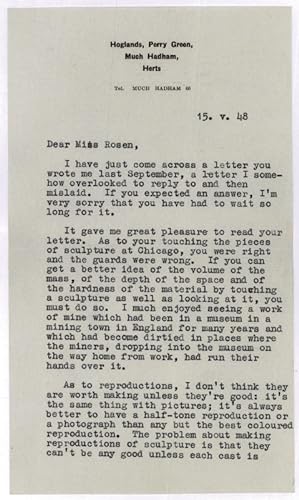
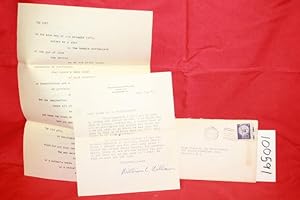
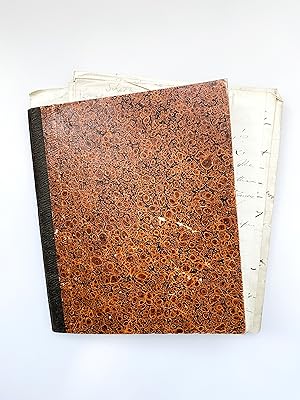
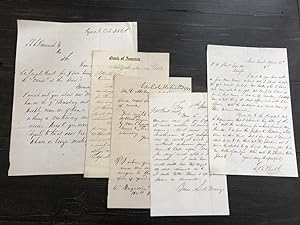
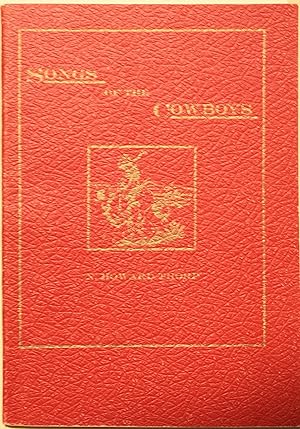
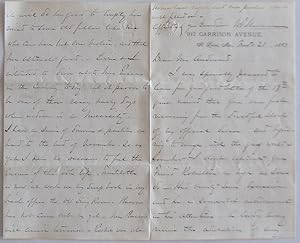
![Seller image for [REPUBLICAN TURKISH UROLOGY and RESEARCHES on HERMAPHRODITES] [Collection of autograph letters, photographs, case registers and other documents]. for sale by Khalkedon Rare Books, IOBA](https://pictures.abebooks.com/inventory/md/md30407290165.jpg)
![Seller image for The Seafighters (The Sea Fighters) [Operation Bikini] [Original Working Screenplay / Script for the 1963 Movie - Operation Bikini] for sale by Bookwood](https://pictures.abebooks.com/inventory/md/md13431620864.jpg)
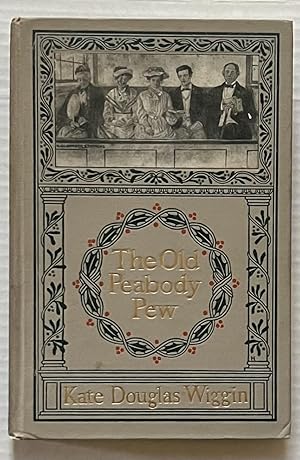
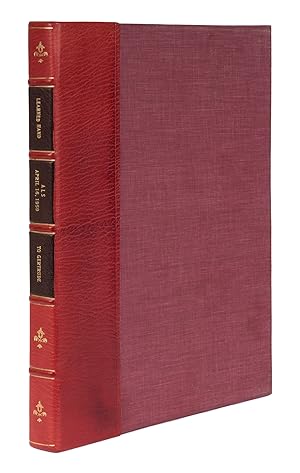
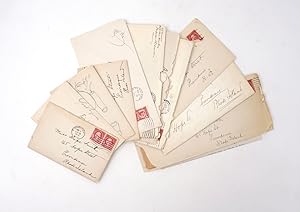
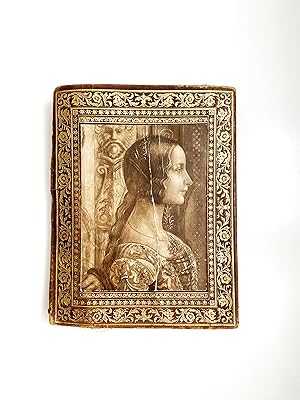
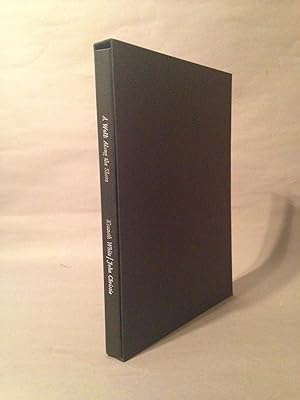
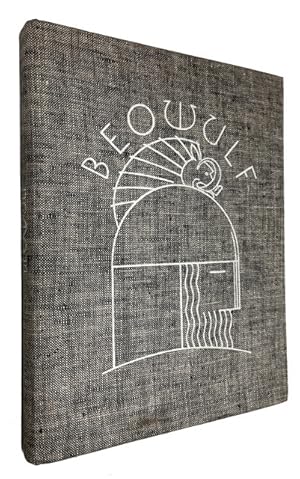
![Seller image for Henry Irving. Ellen Terry. etc. A Book of Portraits [With Typed Letter Signed from the Publisher to Ellen Terry and an ALS from Edward to his Sister, Edith] for sale by Peruse the Stacks](https://pictures.abebooks.com/inventory/md/md31811984979.jpg)
![Seller image for [Archive]: Camp Watitoh 1939 for sale by Between the Covers-Rare Books, Inc. ABAA](https://pictures.abebooks.com/inventory/md/md30006784540.jpg)
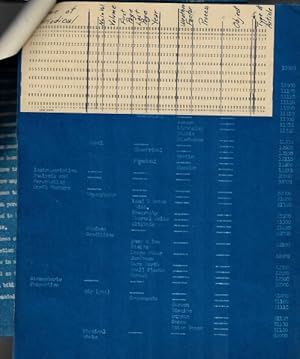
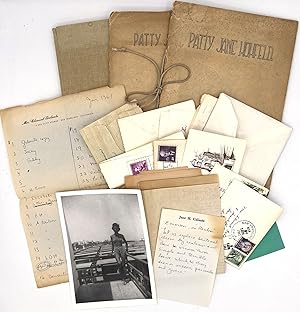
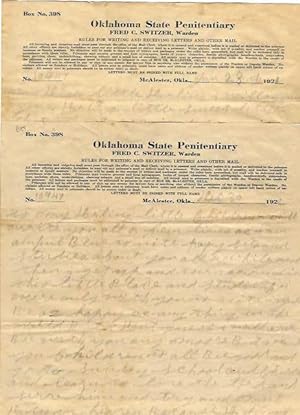
![Seller image for Two Autograph Letters, Signed. BY LADY DOROTHY STANLEY [nee Dorothy Tennant], TO WILLIAM HENRY RIDEING, ABOUT HER HUSBAND, EXPLORER SIR HENRY STANLEY for sale by James Cummins Bookseller, ABAA](https://pictures.abebooks.com/inventory/md/md31834006626.jpg)
![Seller image for [Oxford Circuit in the 1880s.] 27 sketches and caricatures by Lauriston Leonard Batten of barristers (including Lord Loveburn; C. J. Darling), judges and others, including several court scenes; for fellow barrister the future Sir Richard Harington. for sale by Richard M. Ford Ltd](https://pictures.abebooks.com/inventory/md/md30507674230.jpg)
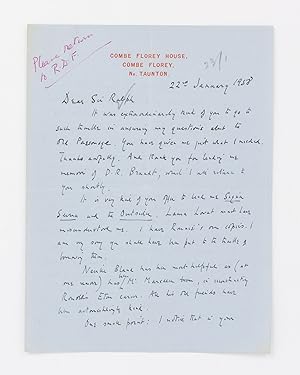
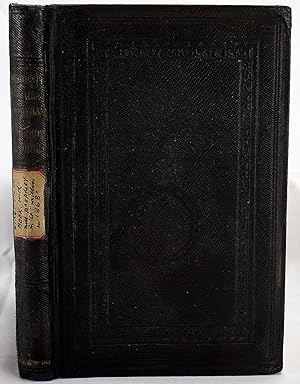
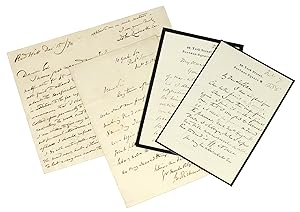
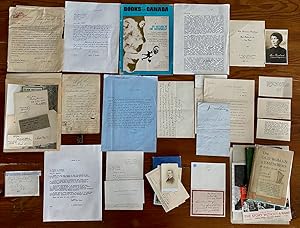
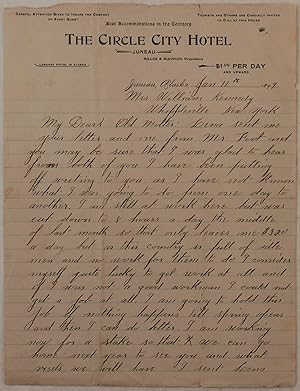
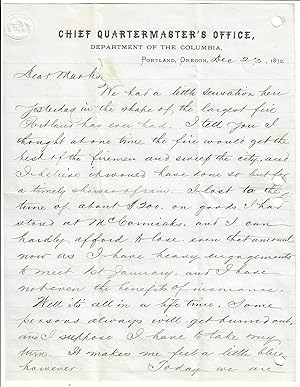

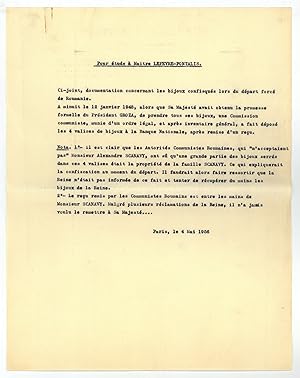
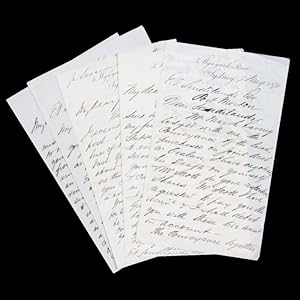
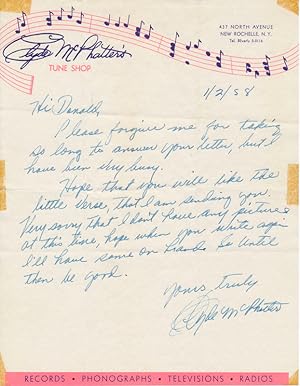
![Seller image for Late Eighteenth-century bread receipts for the household of the Comte De Lannoy. [With:] 9 other pieces of nineteenth and twentieth-century culinary ephemera, including a letterhead of the Royal York Hotel with printed illustration by Phil May, 'The Duchess of Royal York'. for sale by Blackwell's Rare Books ABA ILAB BA](https://pictures.abebooks.com/inventory/md/md31689886148.jpg)
![Seller image for [Archive of Eleven Illustrated Civil War Song Sheets] for sale by Kaaterskill Books, ABAA/ILAB](https://pictures.abebooks.com/inventory/md/md22765844187.jpg)
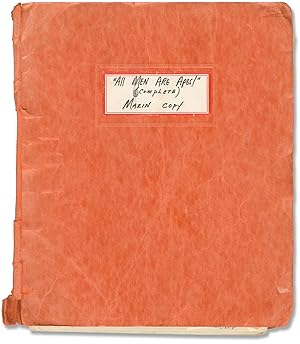
![Seller image for Wood, A (Ca. 1812-1890). A Historically Interesting Original Autograph Letter by One of the Earliest Masons in California and the Founder of Lassen Commandery No. 13 of the Knights Templar at Susanville, Gen. Allen Wood, Informing a Sir Knight from Plumas County and a Pioneer California Lawyer about the "Cold Blooded Affair" of One of the Earliest Murders Investigated in Lassen County, Mentioning "A Considerable Feeling" Among the Inhabitants about the Prisoner's Expected Arrival in Susanville, and Discussing the Commandery's Decision to "Indefinitely Postpone" the Celebration of Ascension Day. Susanville [Lassen County], 20 April 1880. for sale by Globus Rare Books & Archives](https://pictures.abebooks.com/inventory/md/md31429411430.jpg)
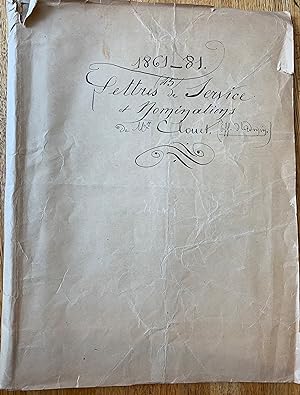
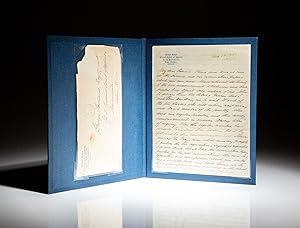
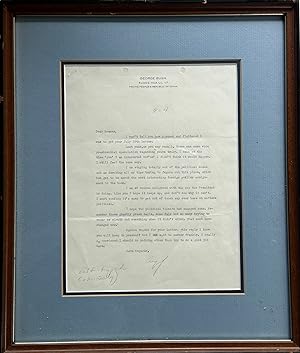
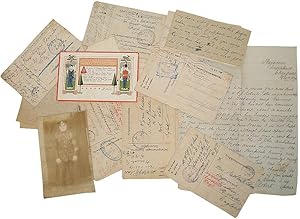
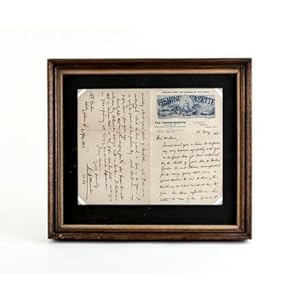
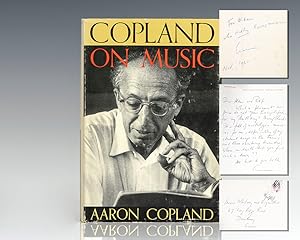
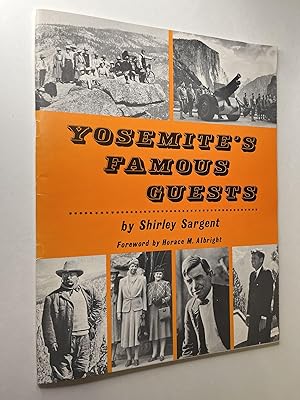
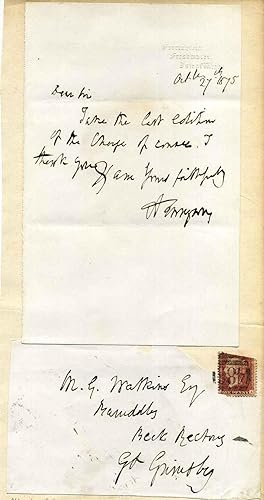
![Seller image for Dossier related to artist Morris Graves from Peter Selz Files, including:The Visionary Art Of Morris Graves, essay by Peter Selz.Morris Graves: Vision of the Inner Eye, Phillips Collection (Washington, DC), folded exhibition poster, 1983.ALS on card, Eric Brown (of Tibor De Nagy Gallery, NYC) to Peter Selz, re: Morris Graves catalogue [2010].ALS Neal [Benezra] (of SFMOMA) to Peter Selz, [2009], response involving Selz's request to borrow a Graves piece for exhibition at the Meridian Gallery.Copy of TLS Eric Brown (of Tibor De Nagy Gallery, NYC) to Peter Selz, re: Morris Graves, 2009.Morris Graves, Frederick S. Wight, John I. H. Baur, Duncan Phillips; UC Press, 1956; signed & dated by Peter Selz, 1956, inside cover.File full of Morris Graves exhibition brochures, color prints, press releases, & related material. for sale by Wittenborn Art Books](https://pictures.abebooks.com/inventory/md/md30057036622.jpg)
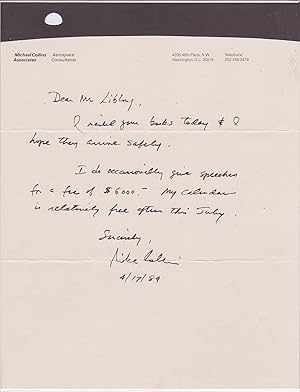
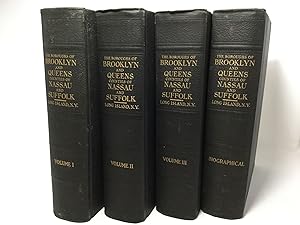
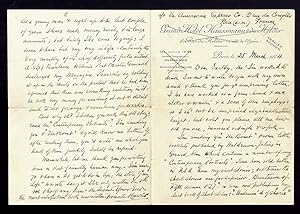
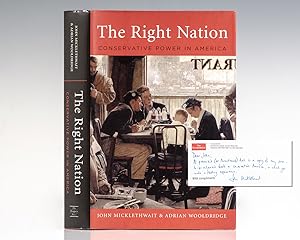
![Seller image for [Darwin's closest friend: Sir Joseph Dalton Hooker, botanist and explorer, Director of the Royal Botanical Gardens, Kew.] Two Autograph Letters Signed to Thomas Lister, regarding seeds and an account of 'negro' handling of poisons. for sale by Richard M. Ford Ltd](https://pictures.abebooks.com/inventory/md/md31751065180.jpg)
